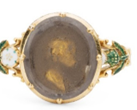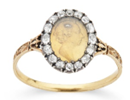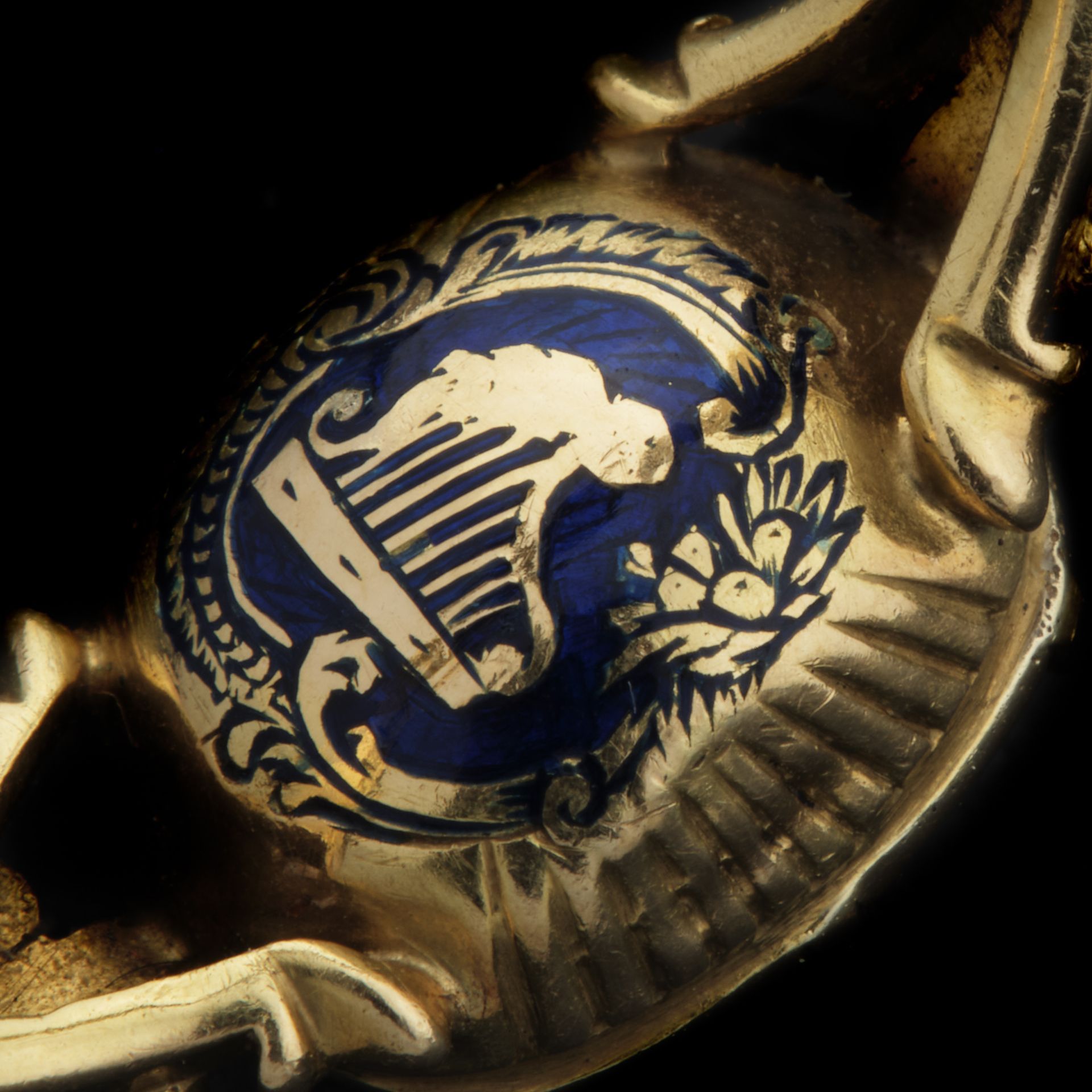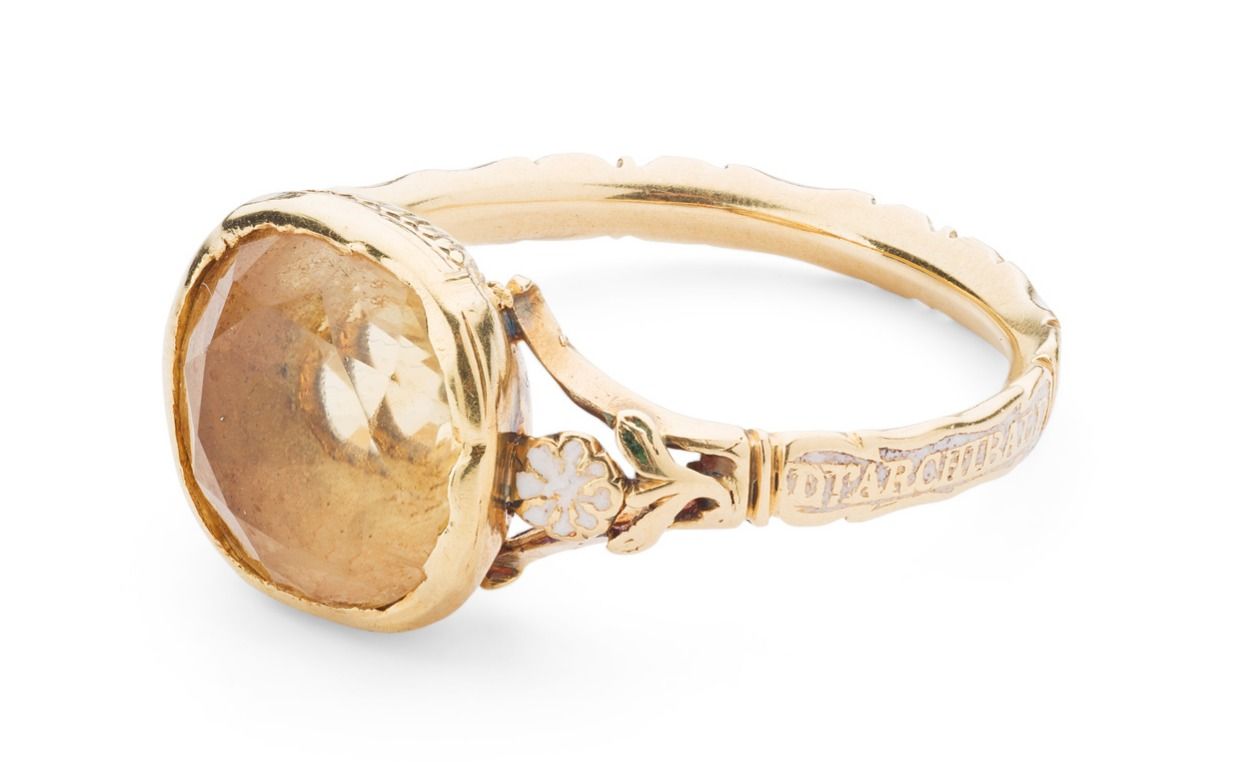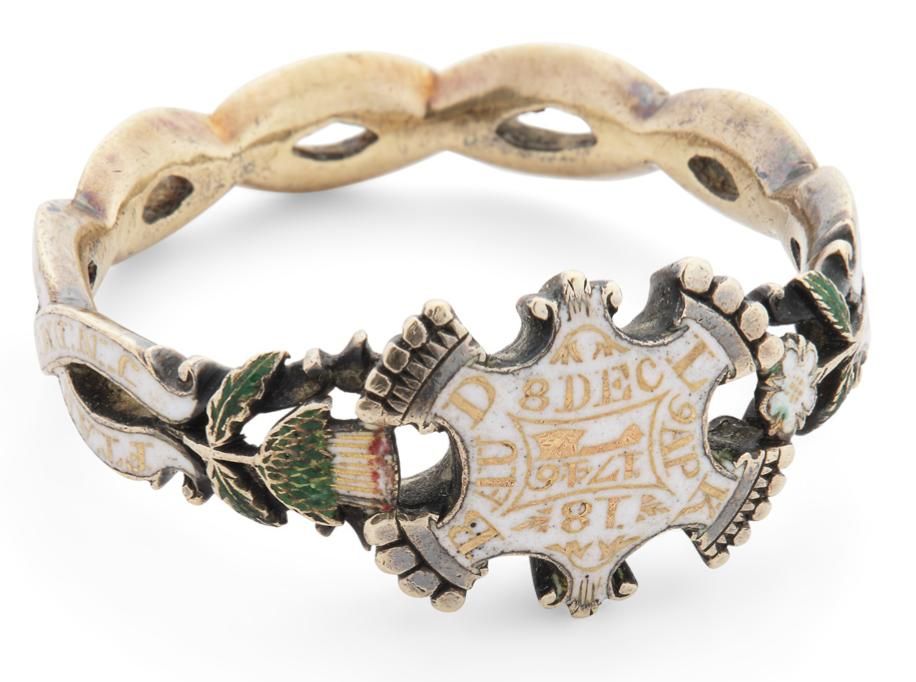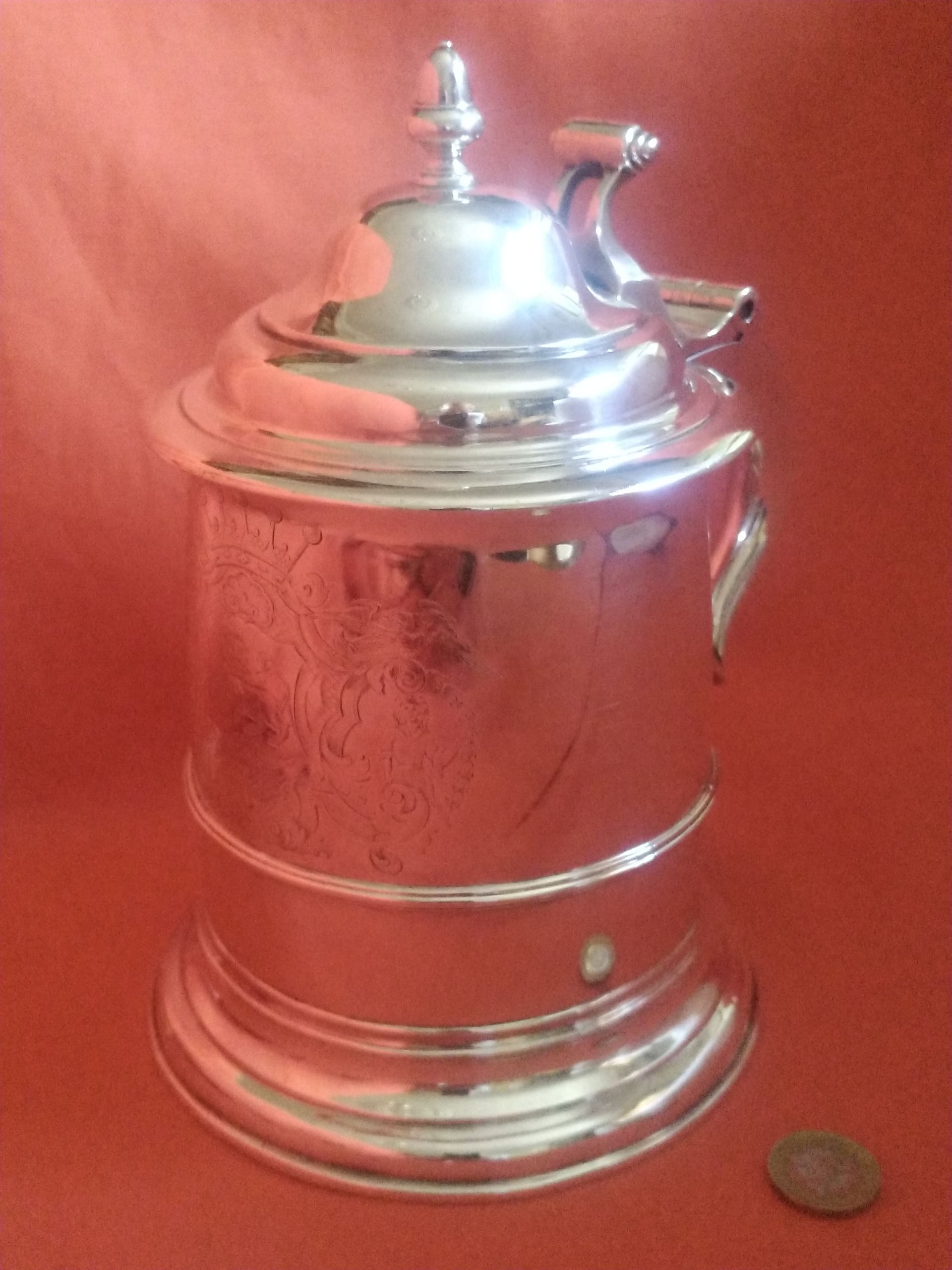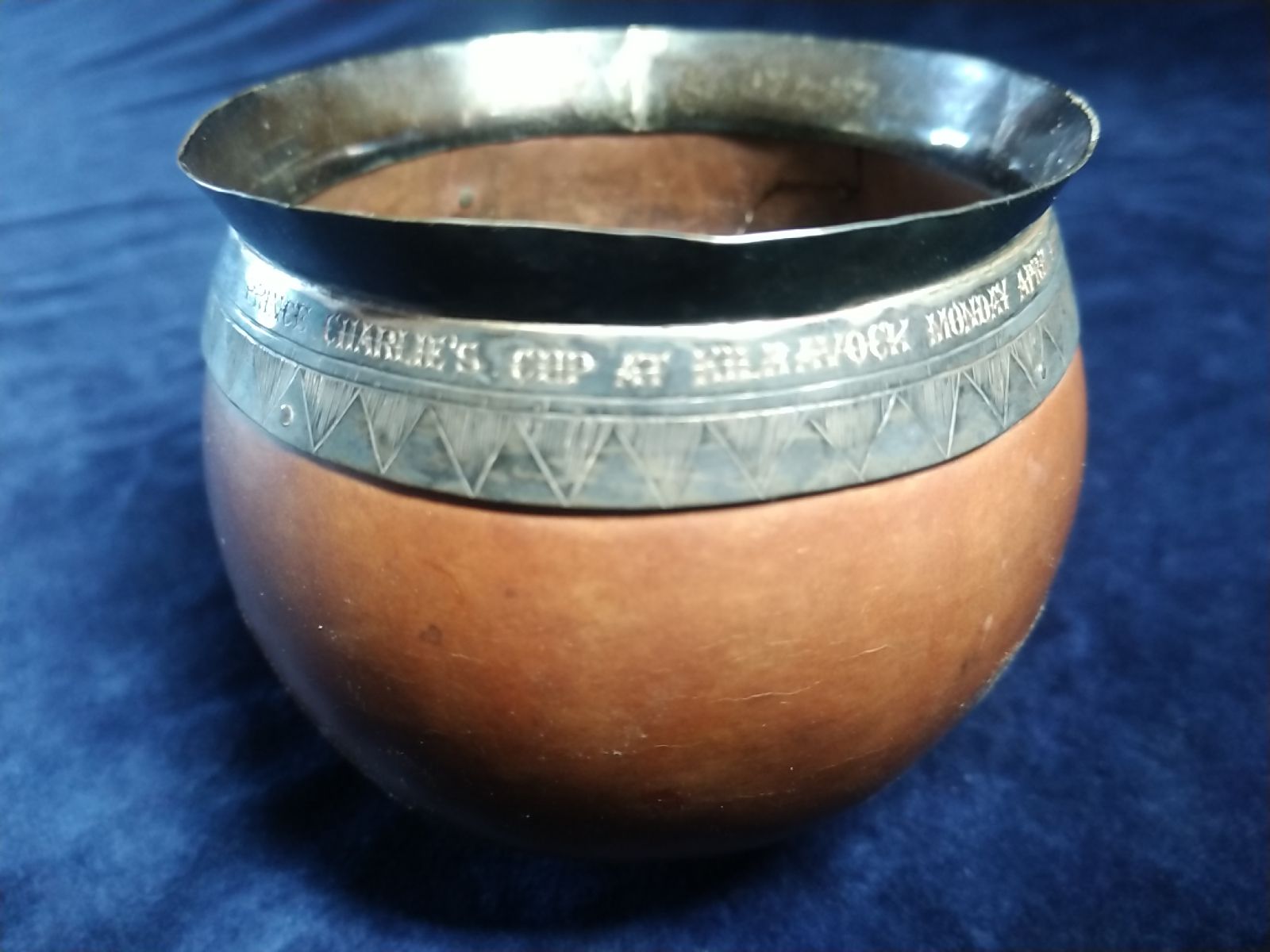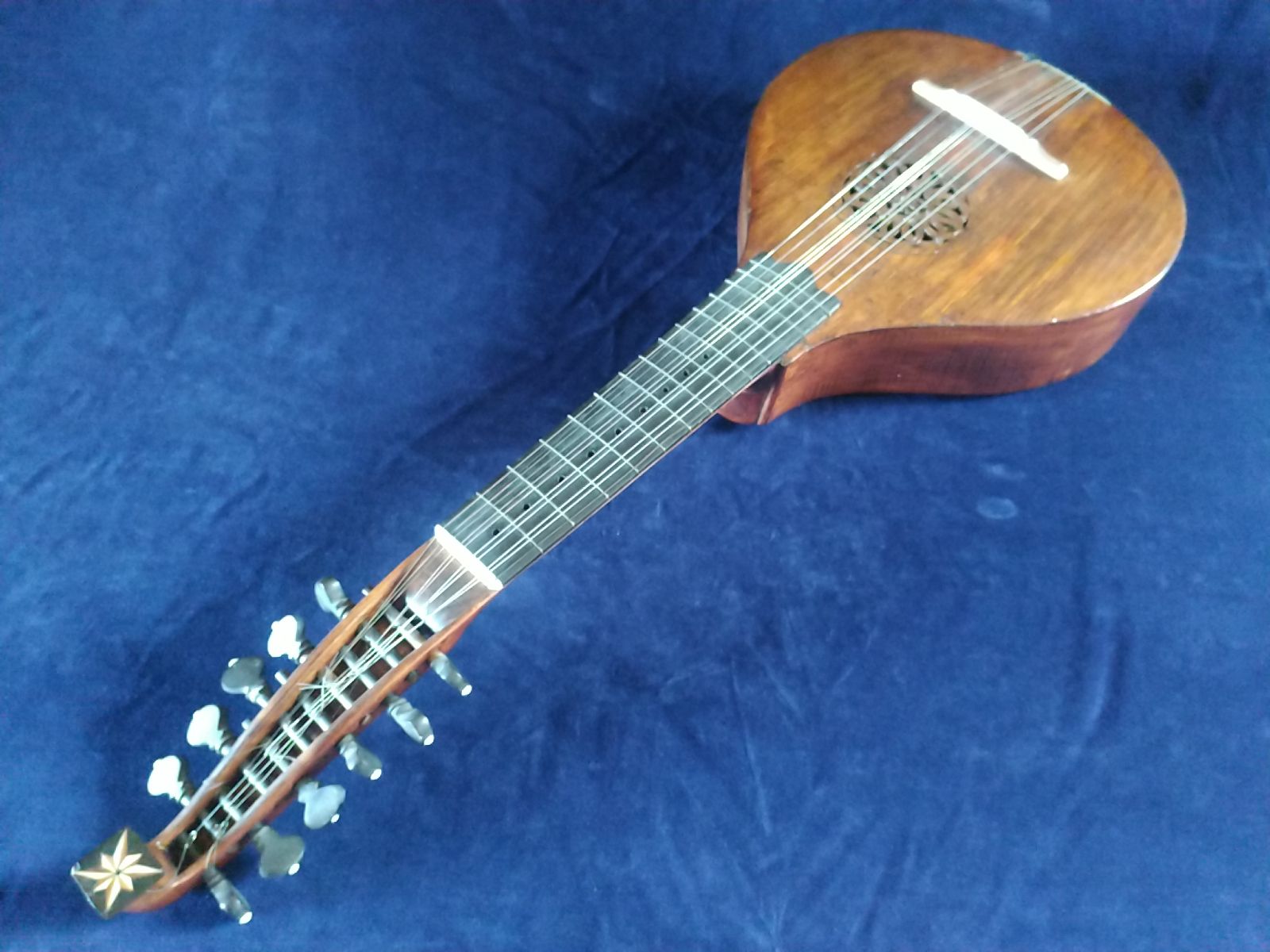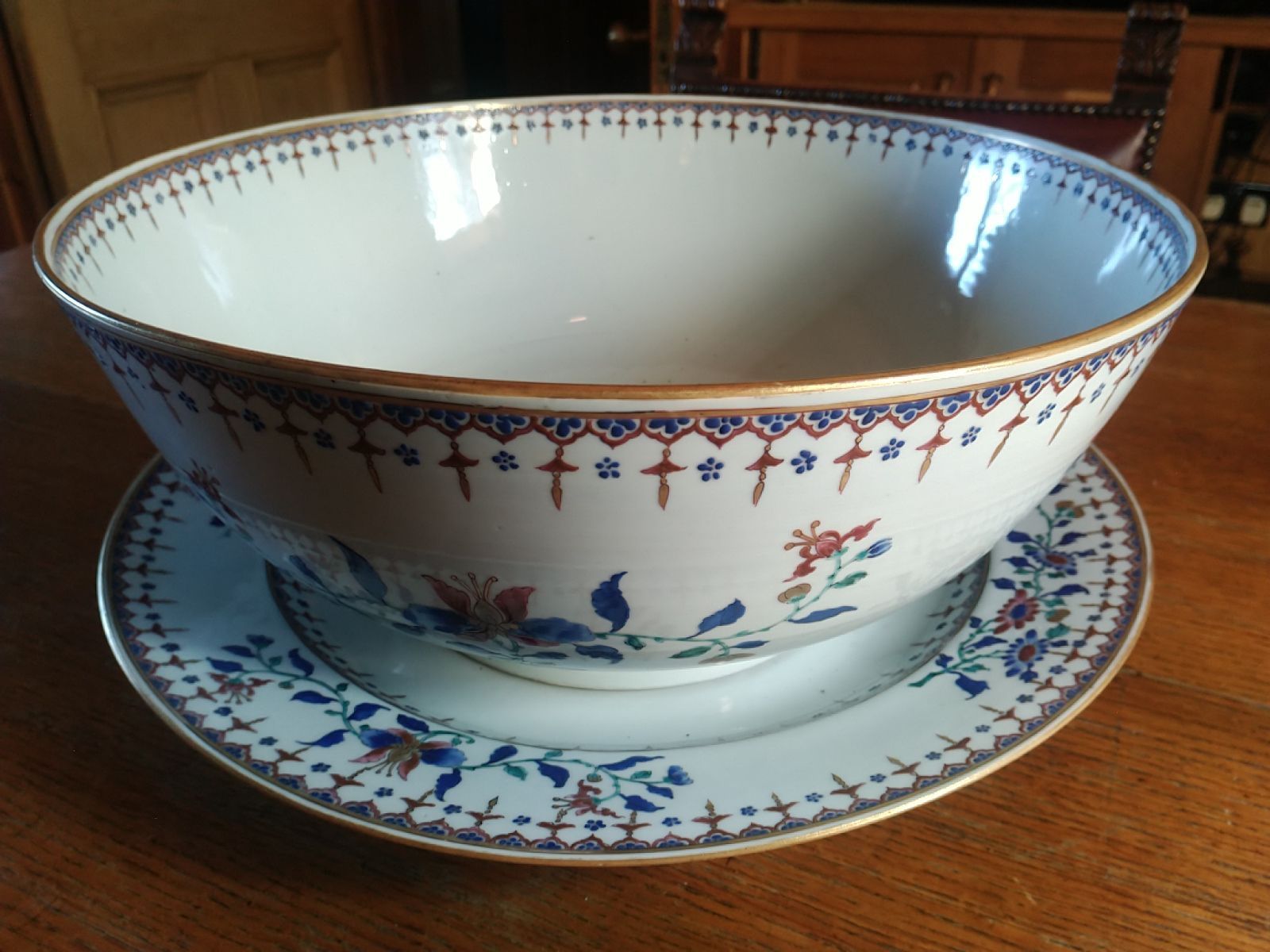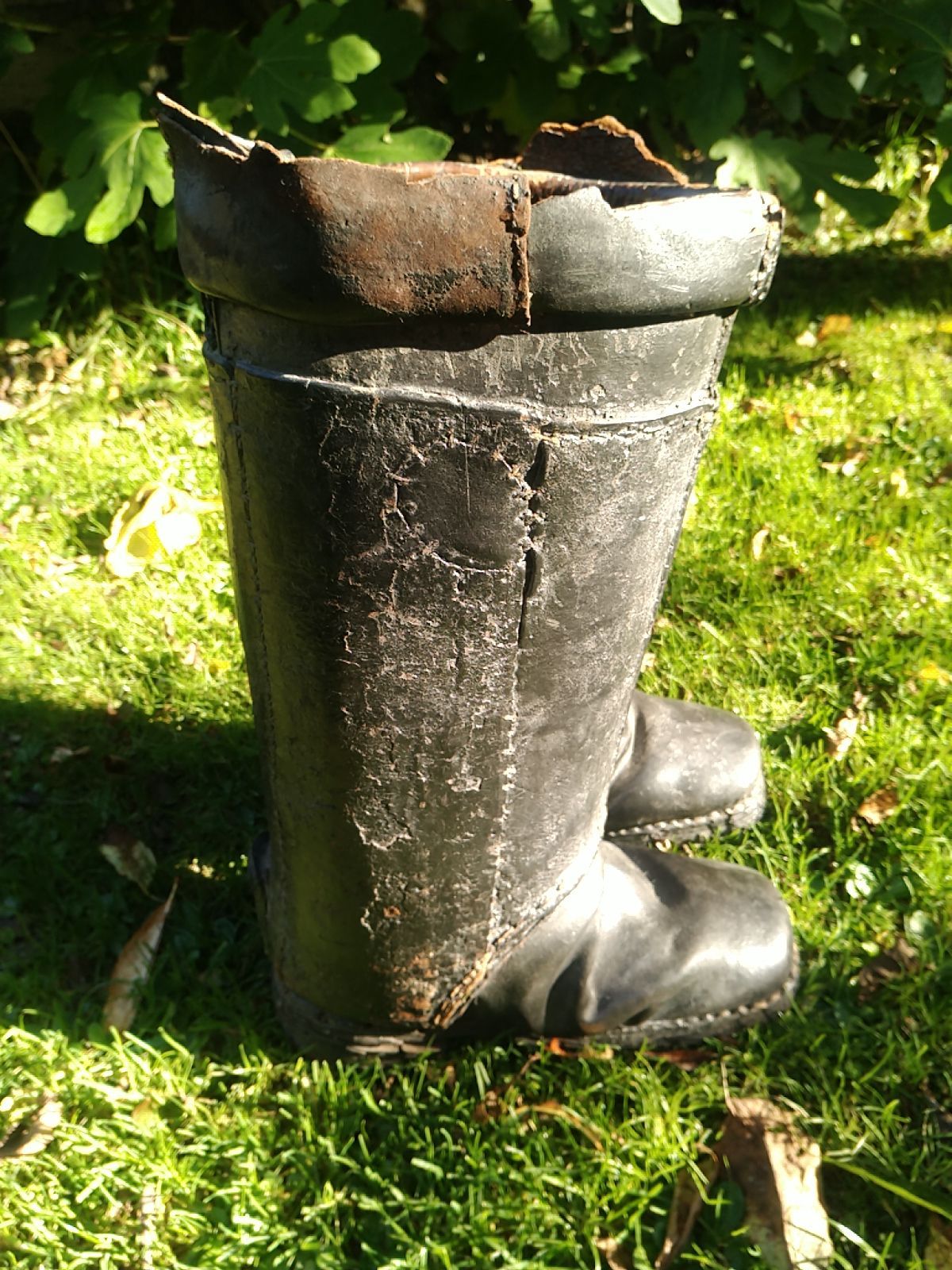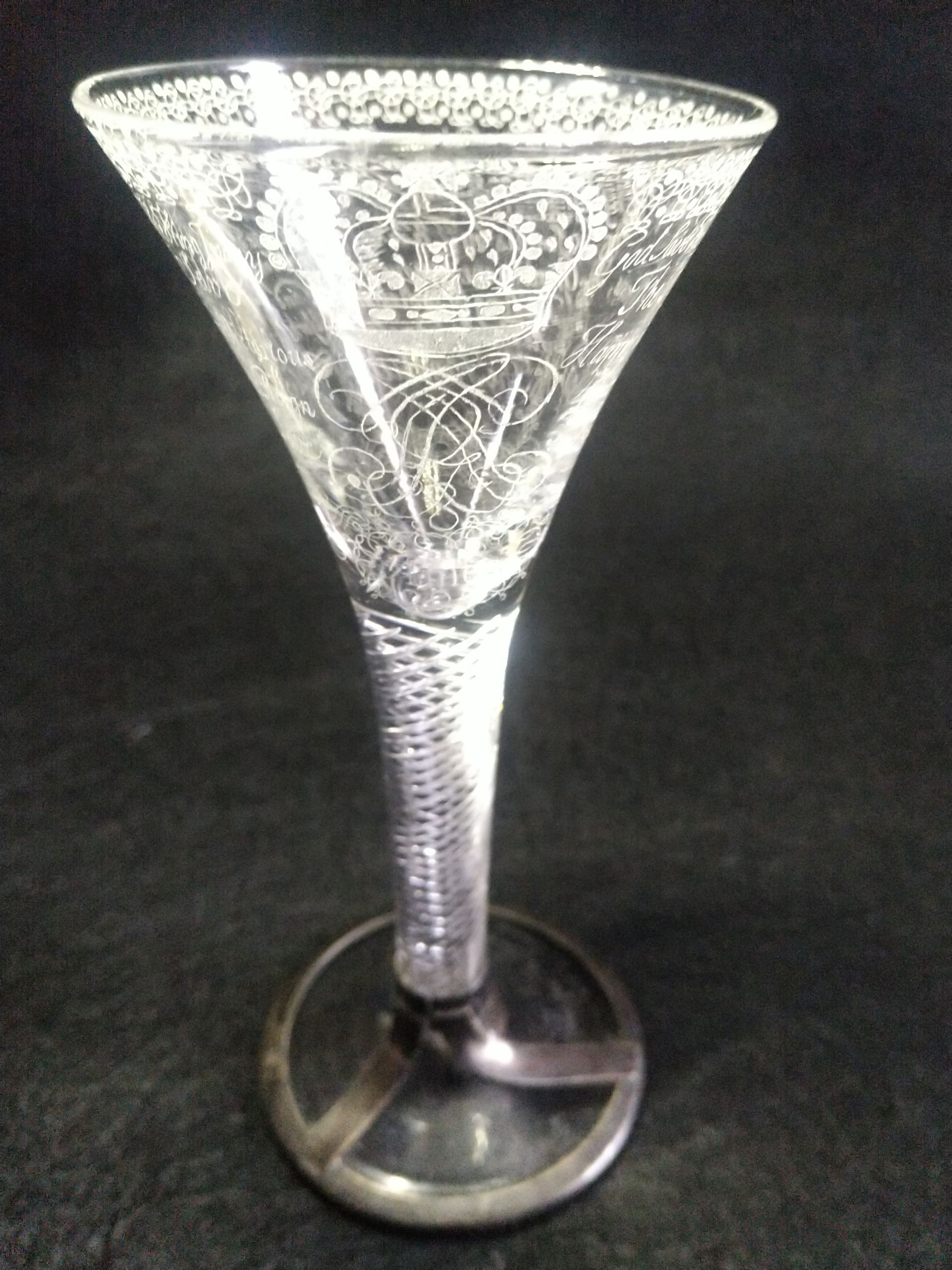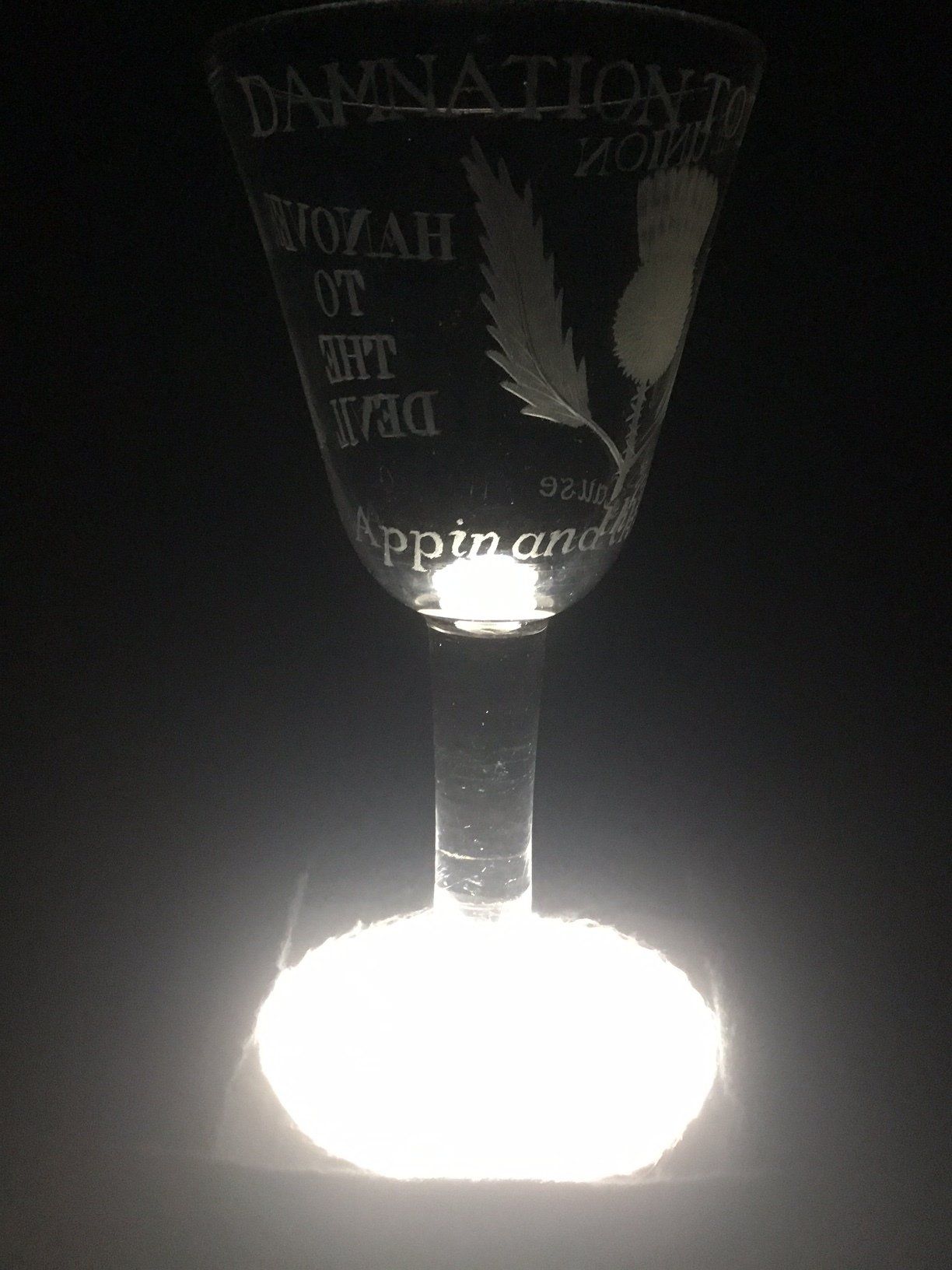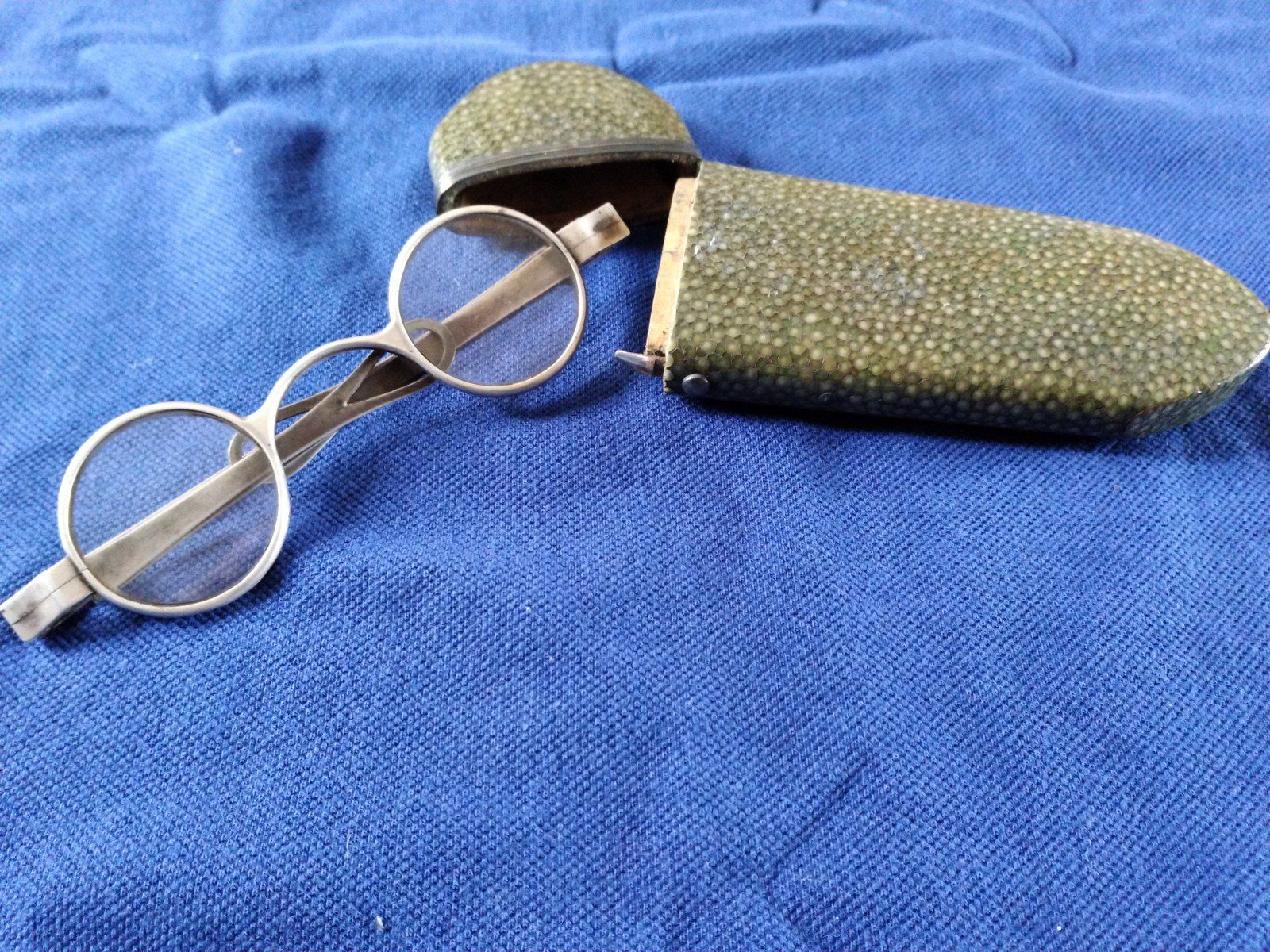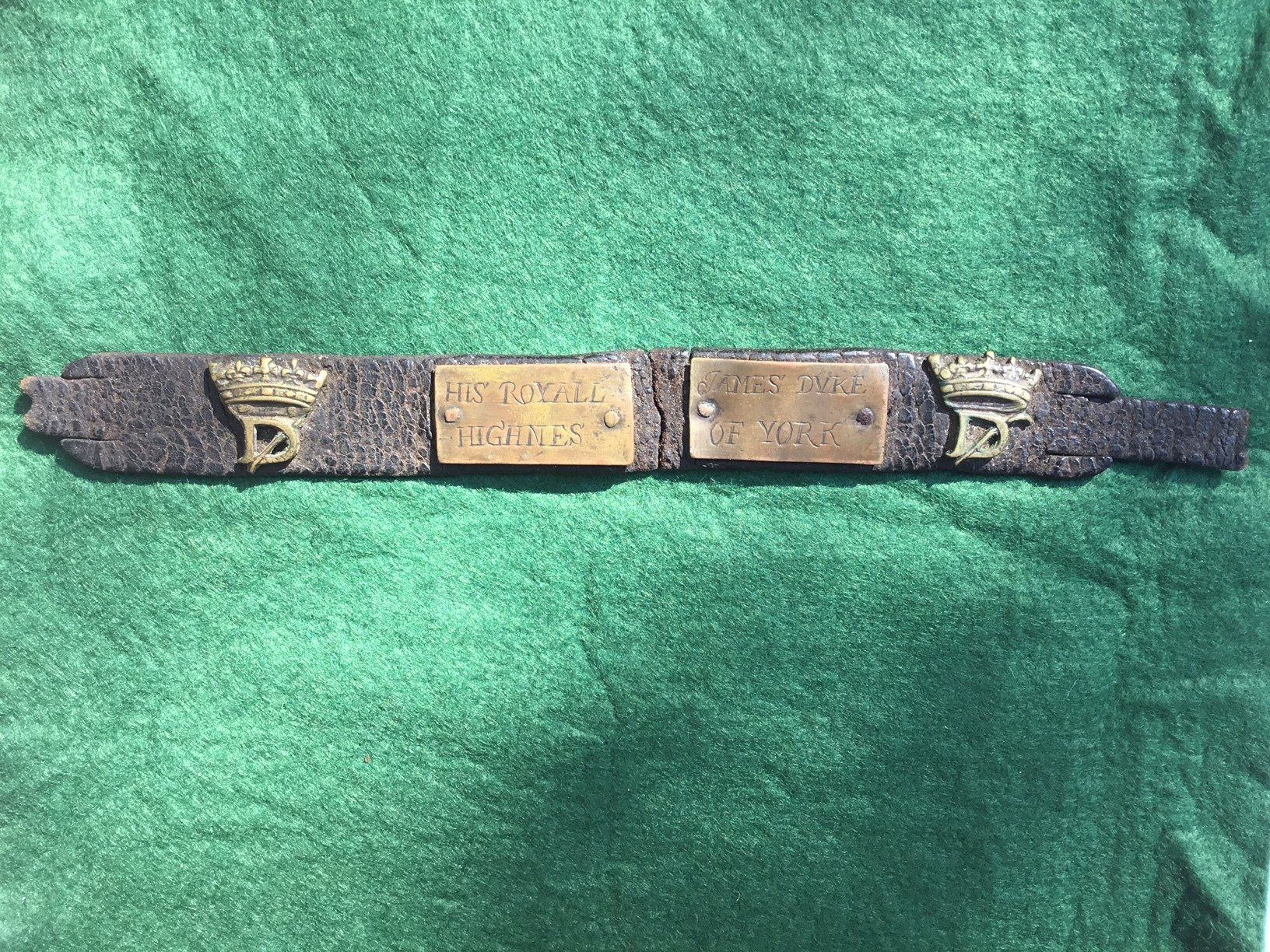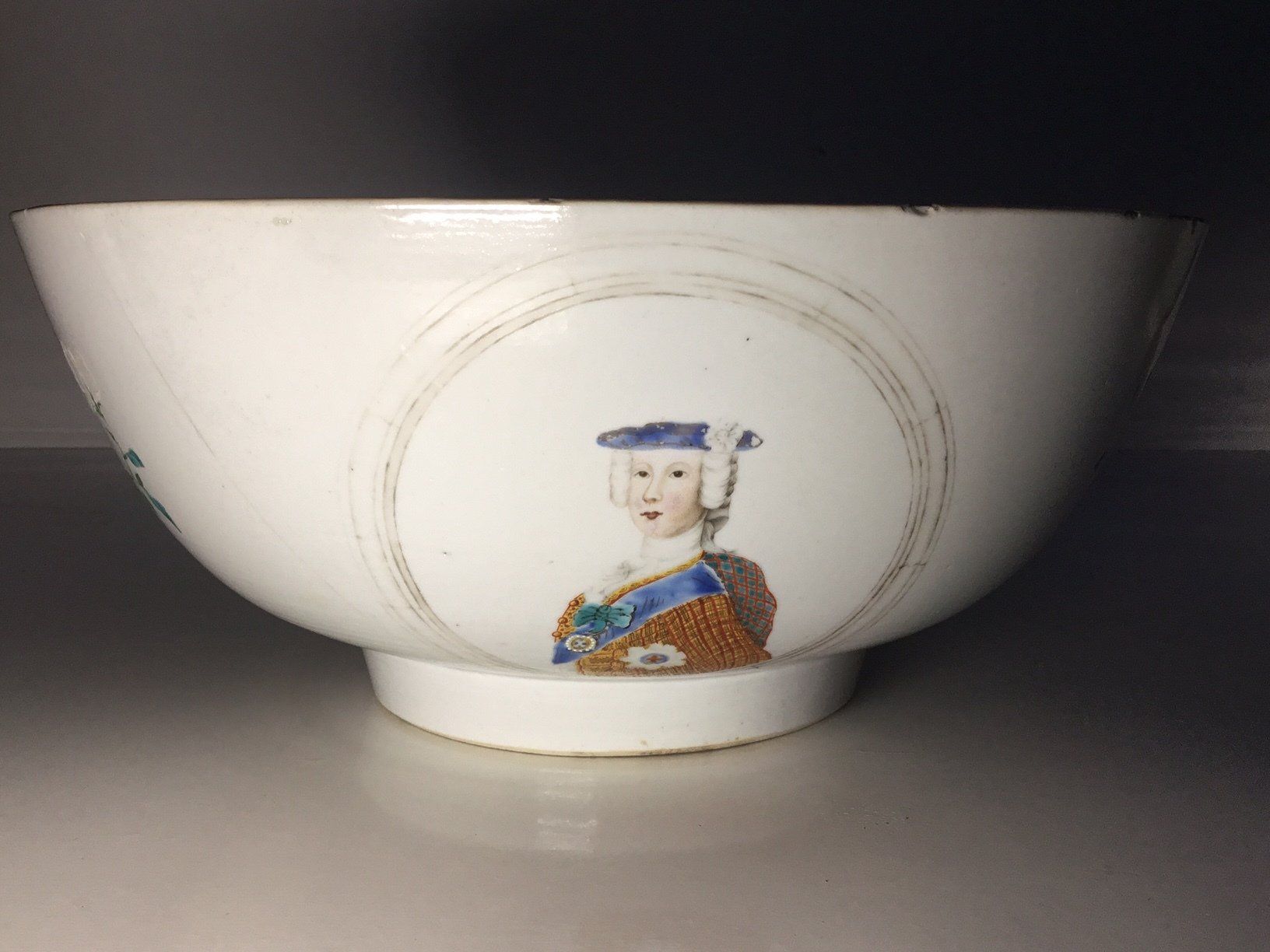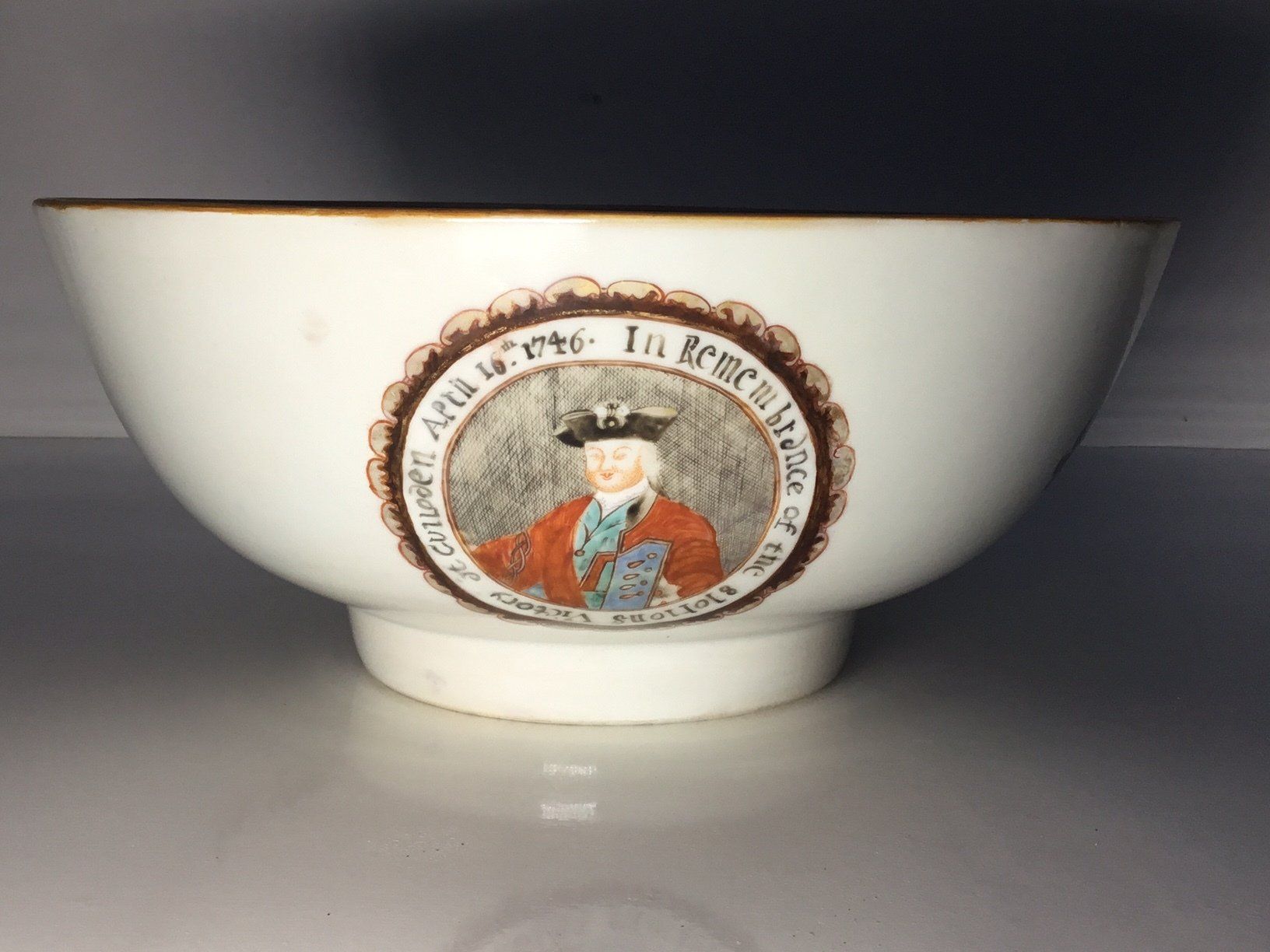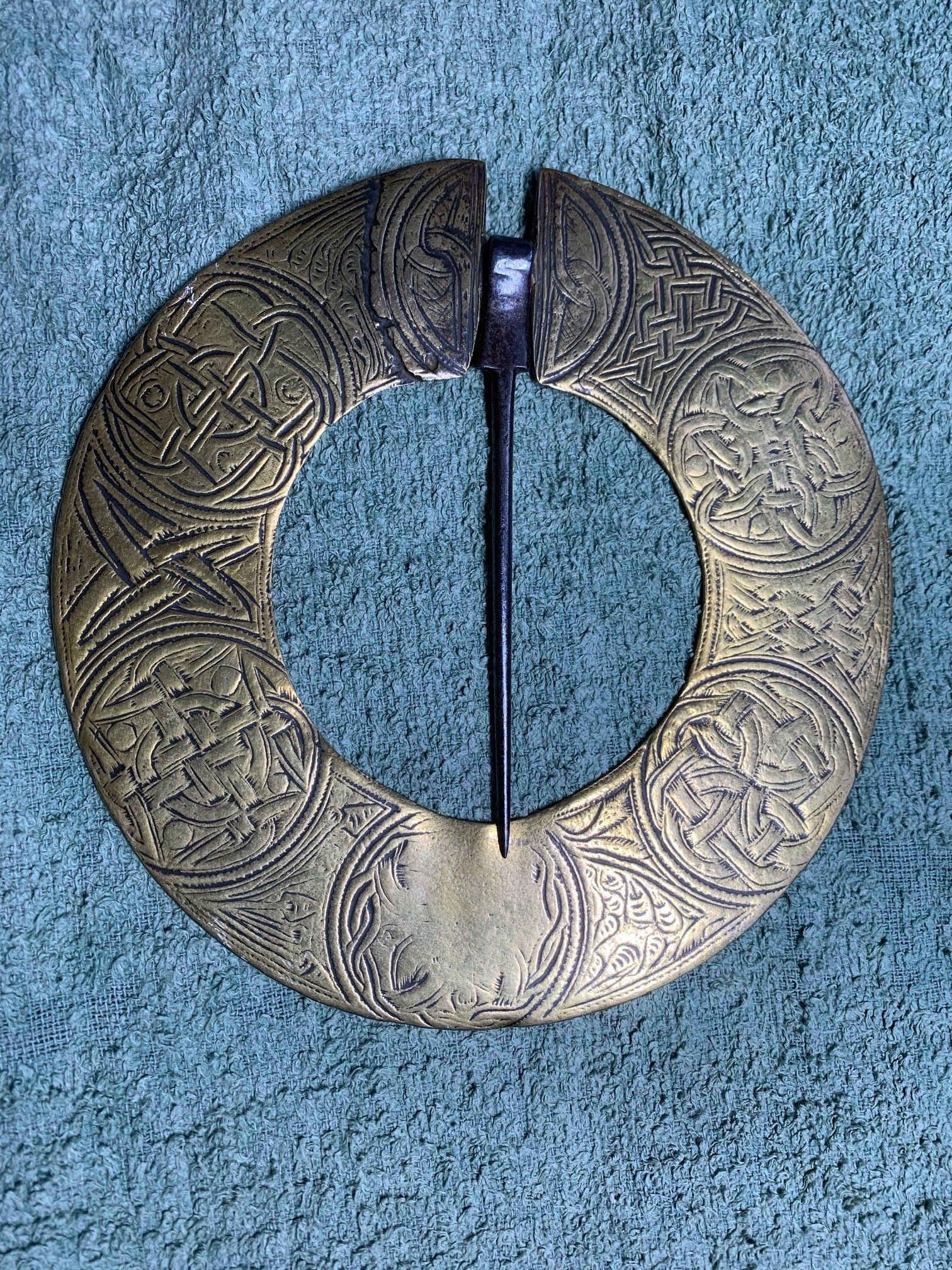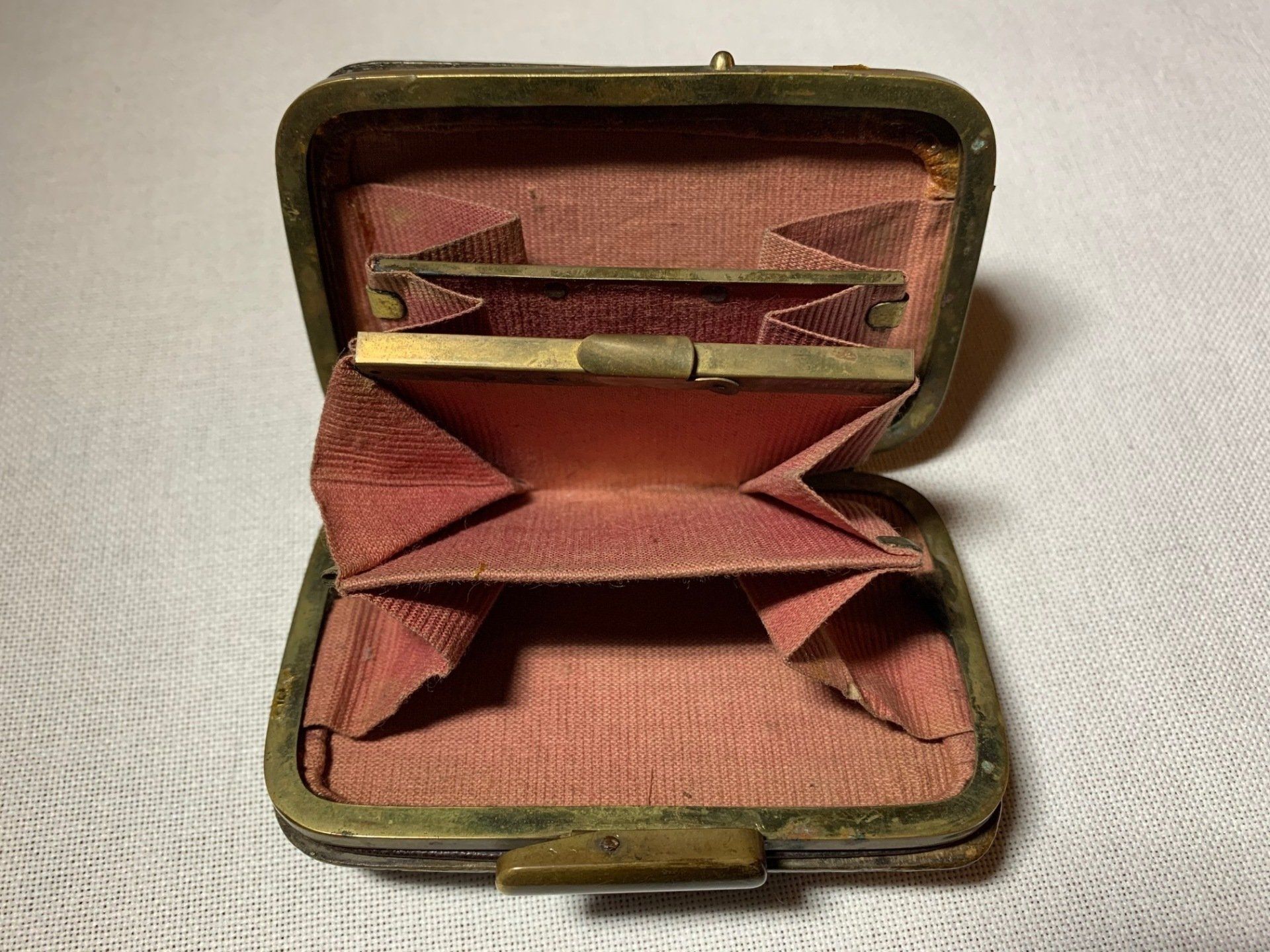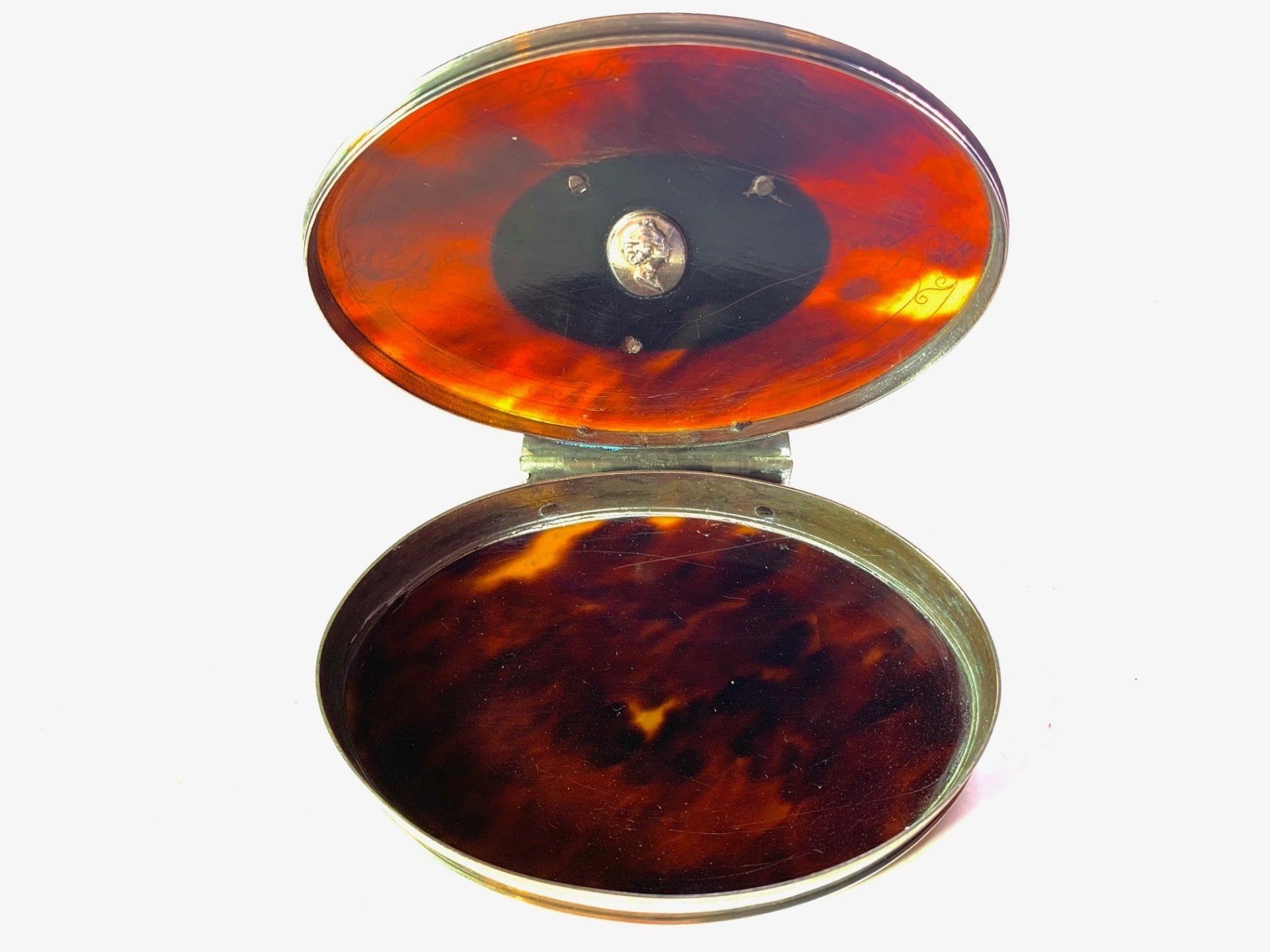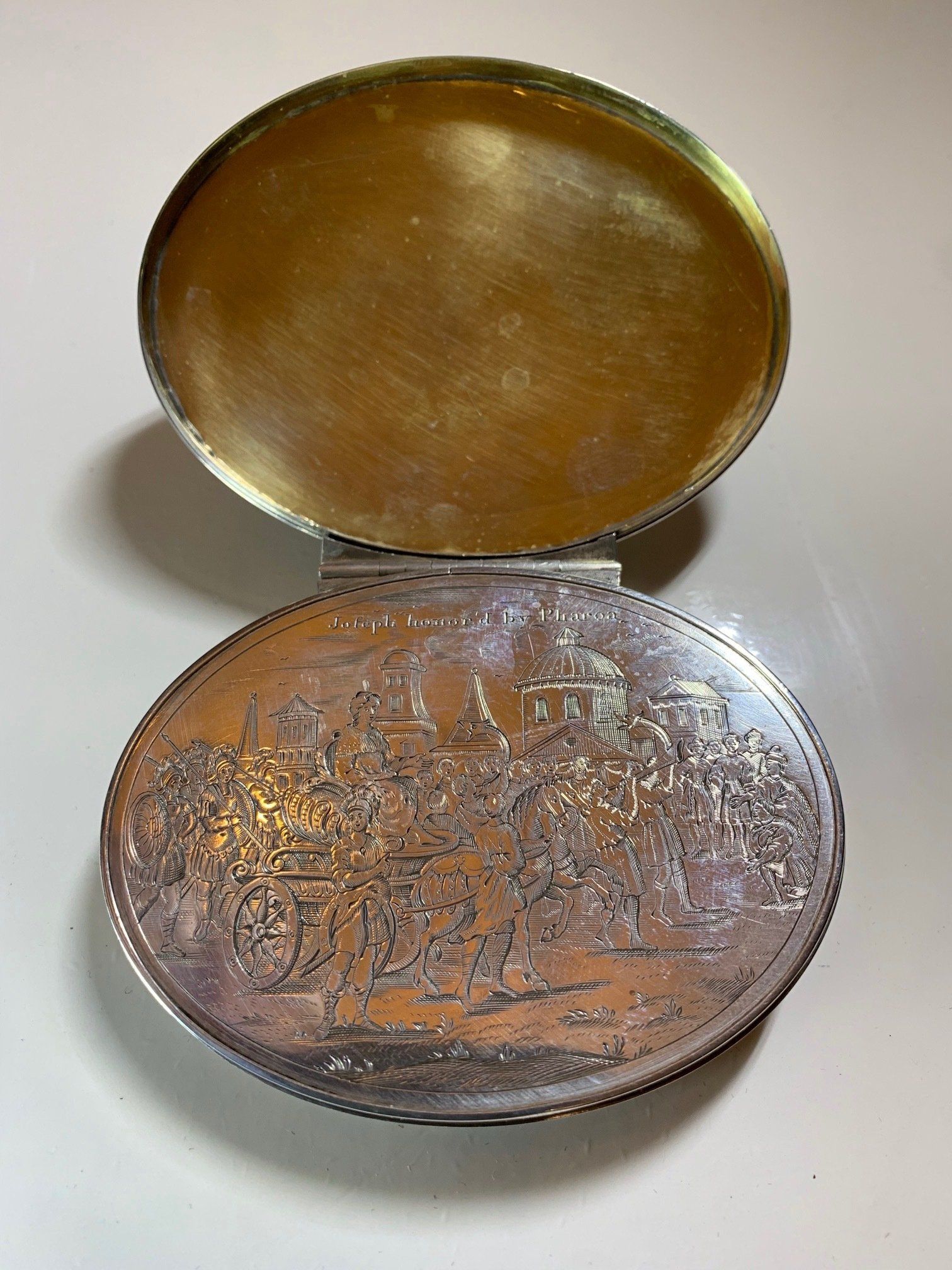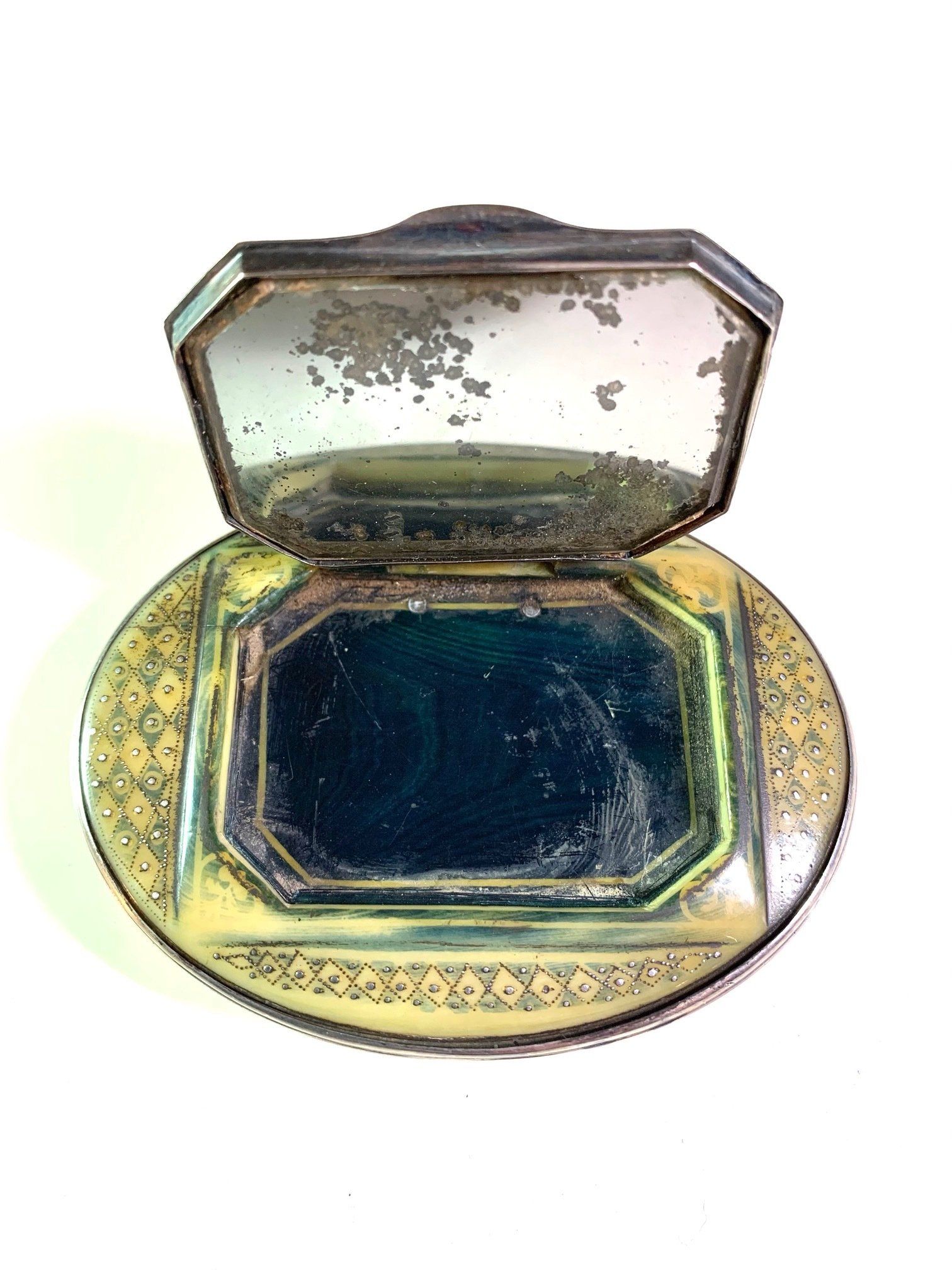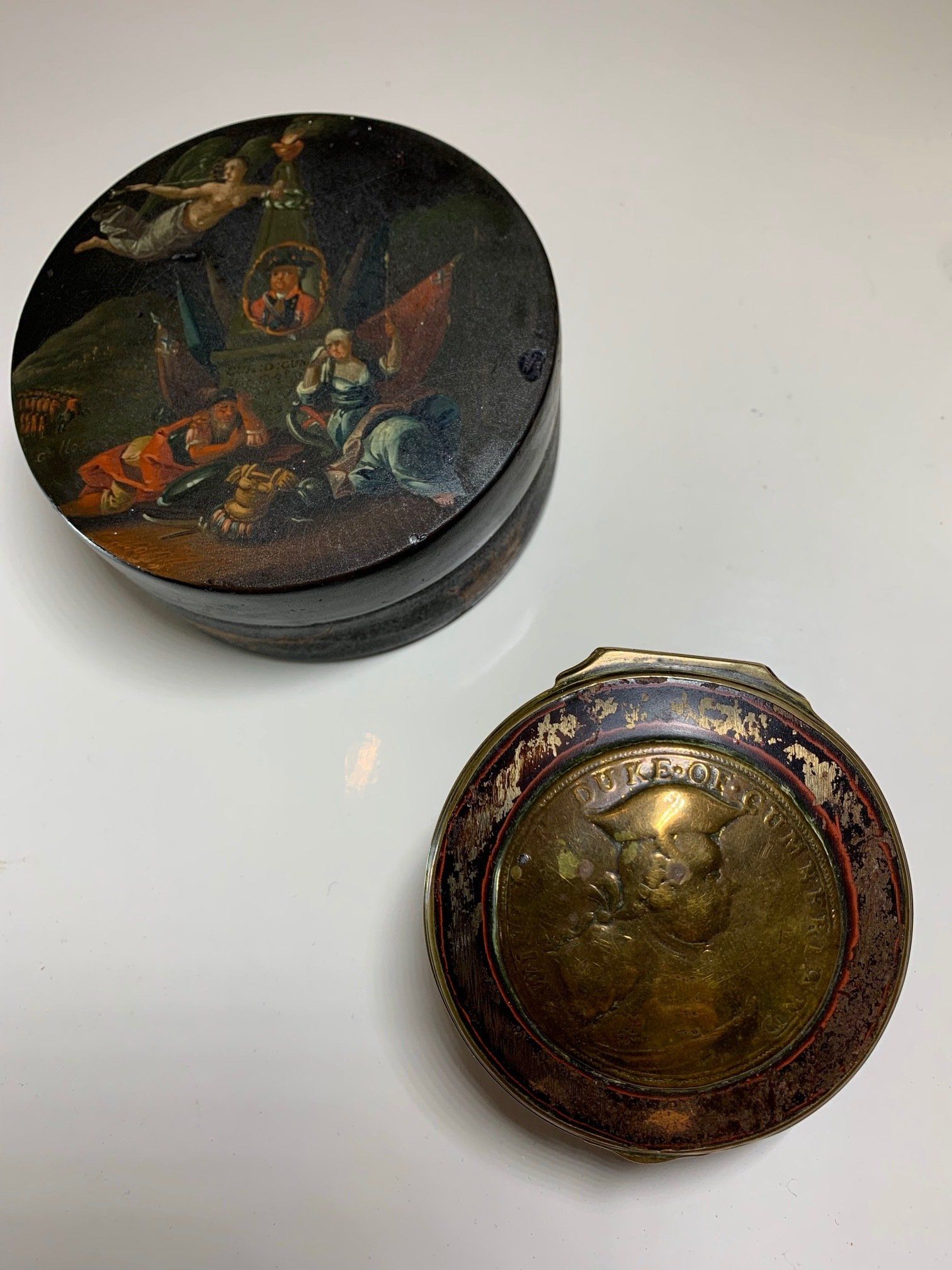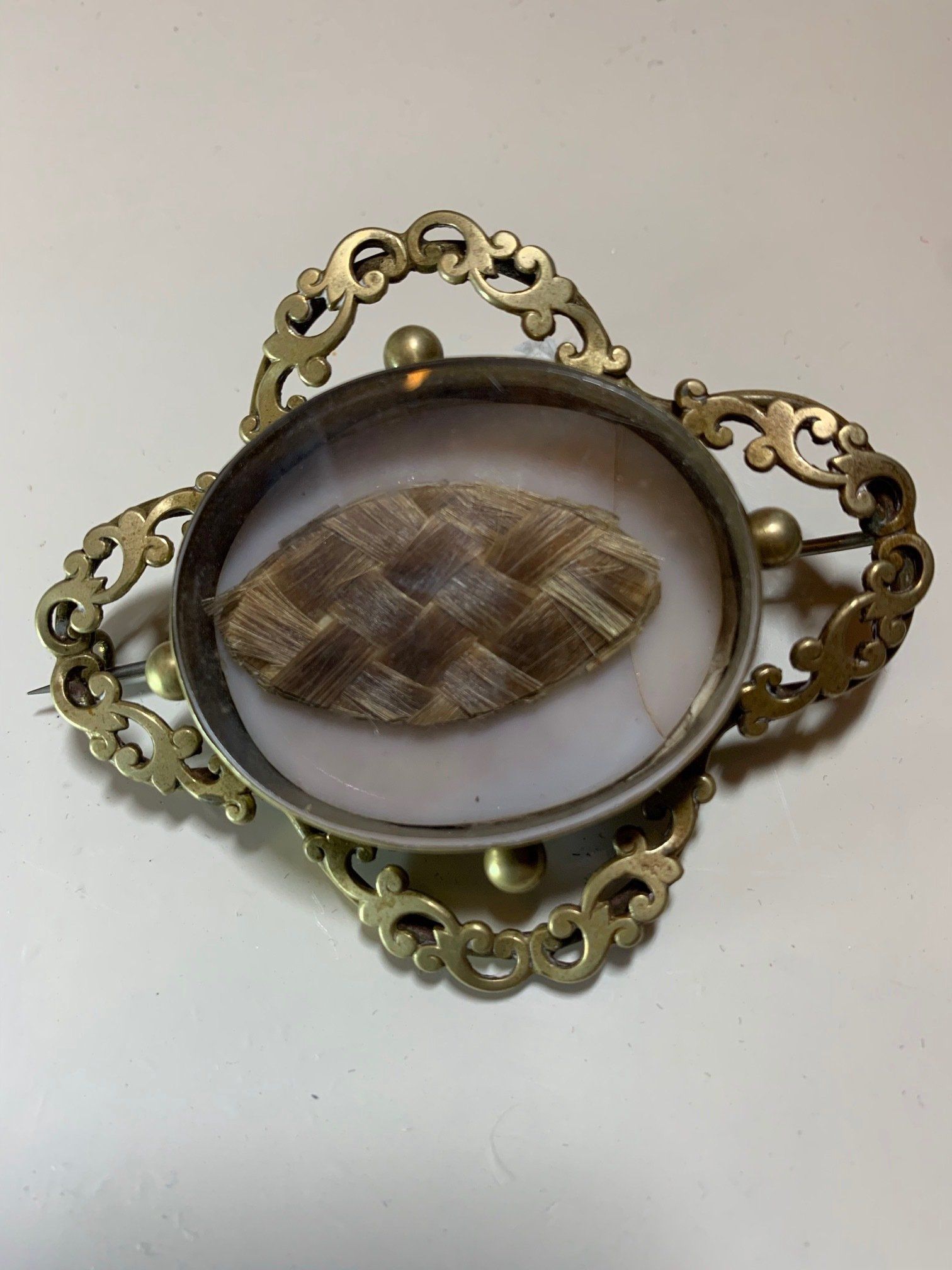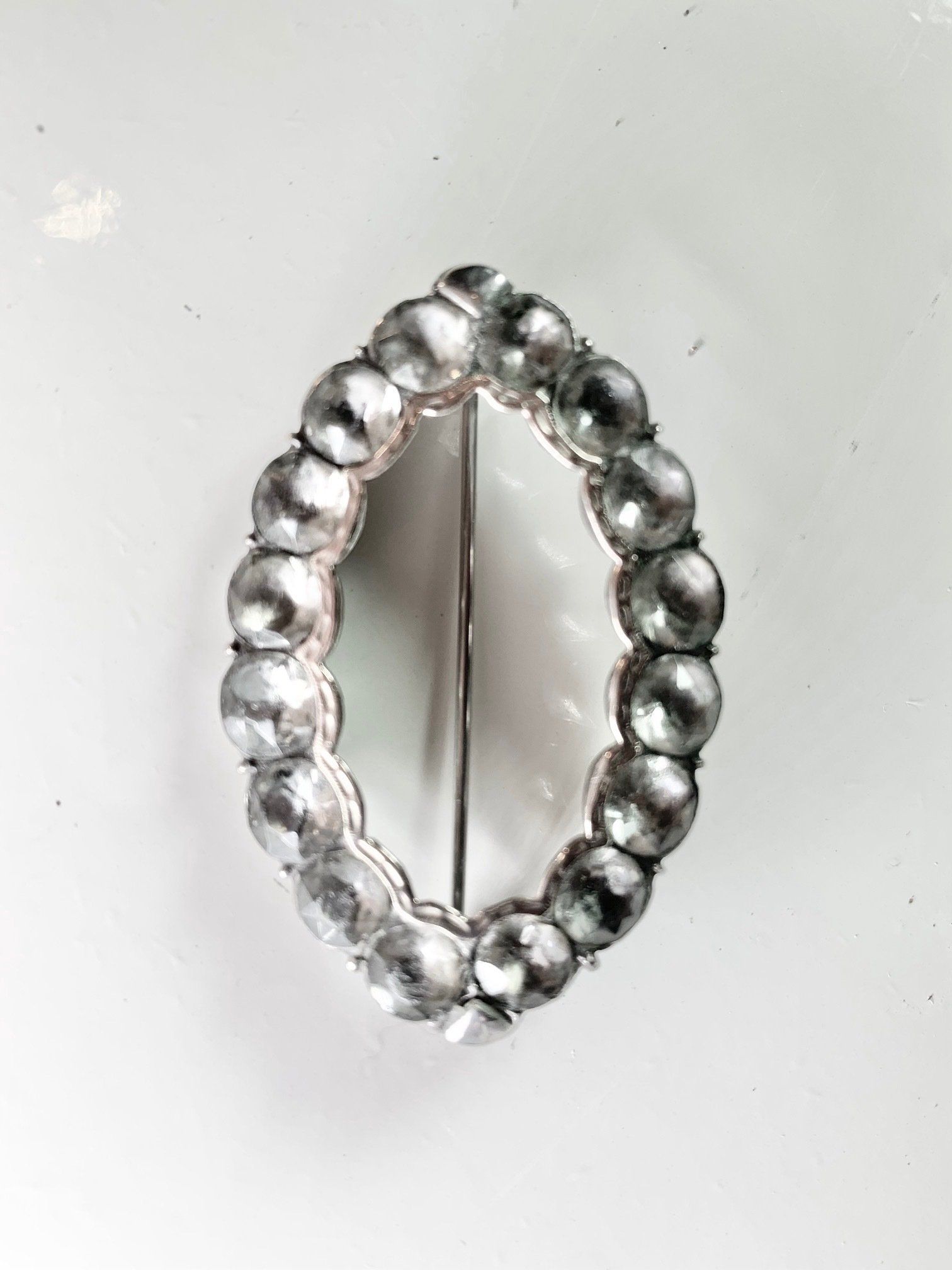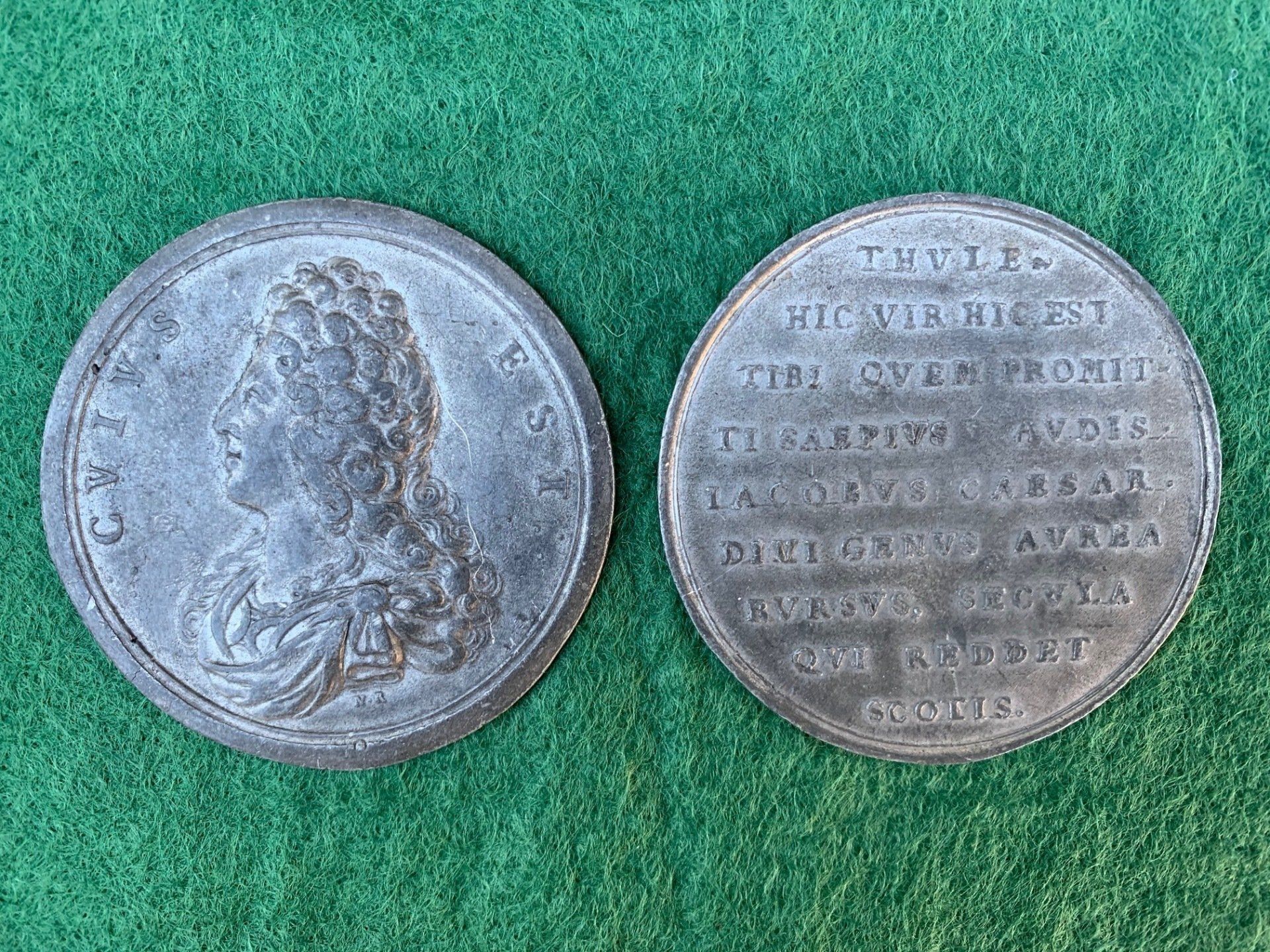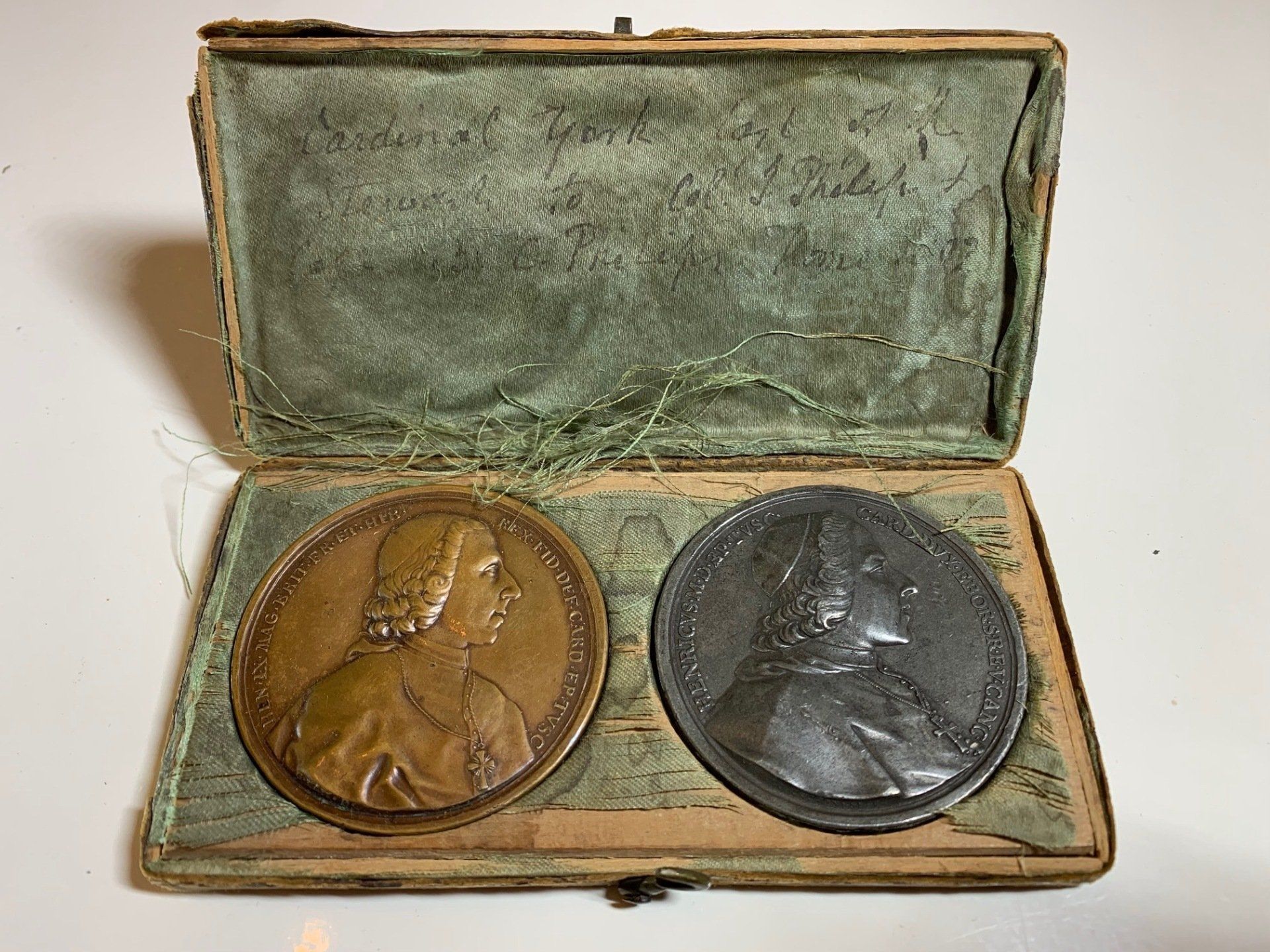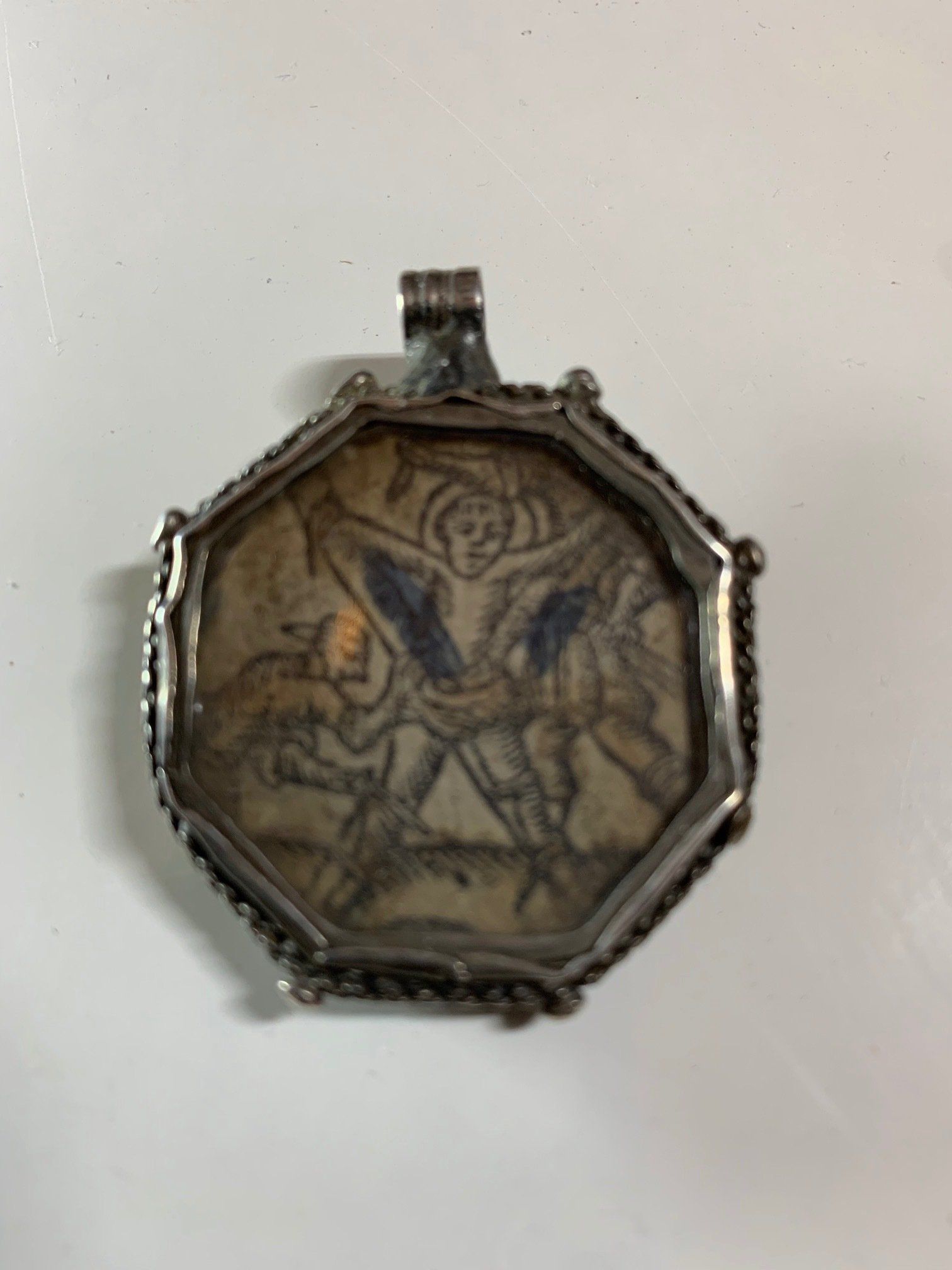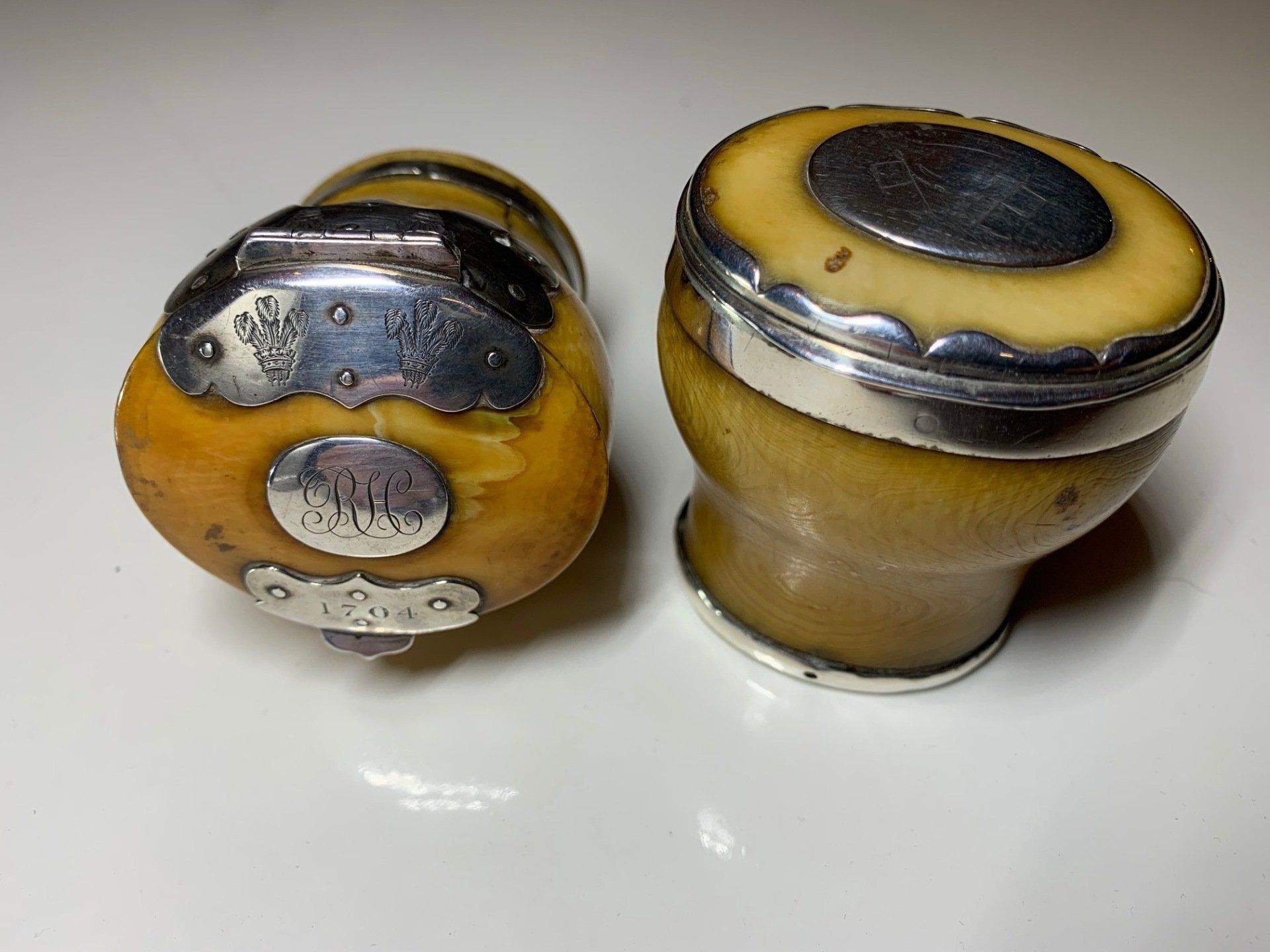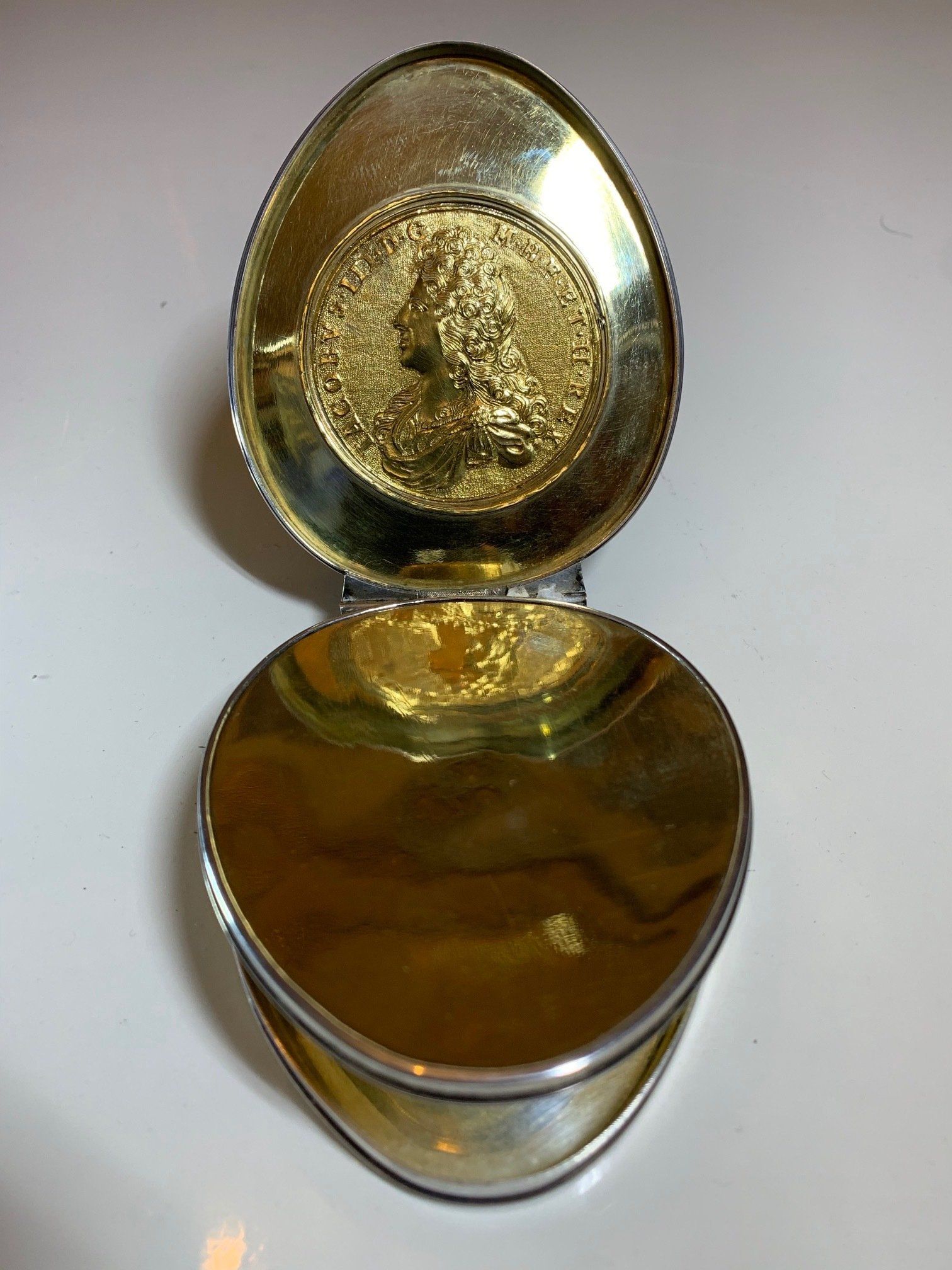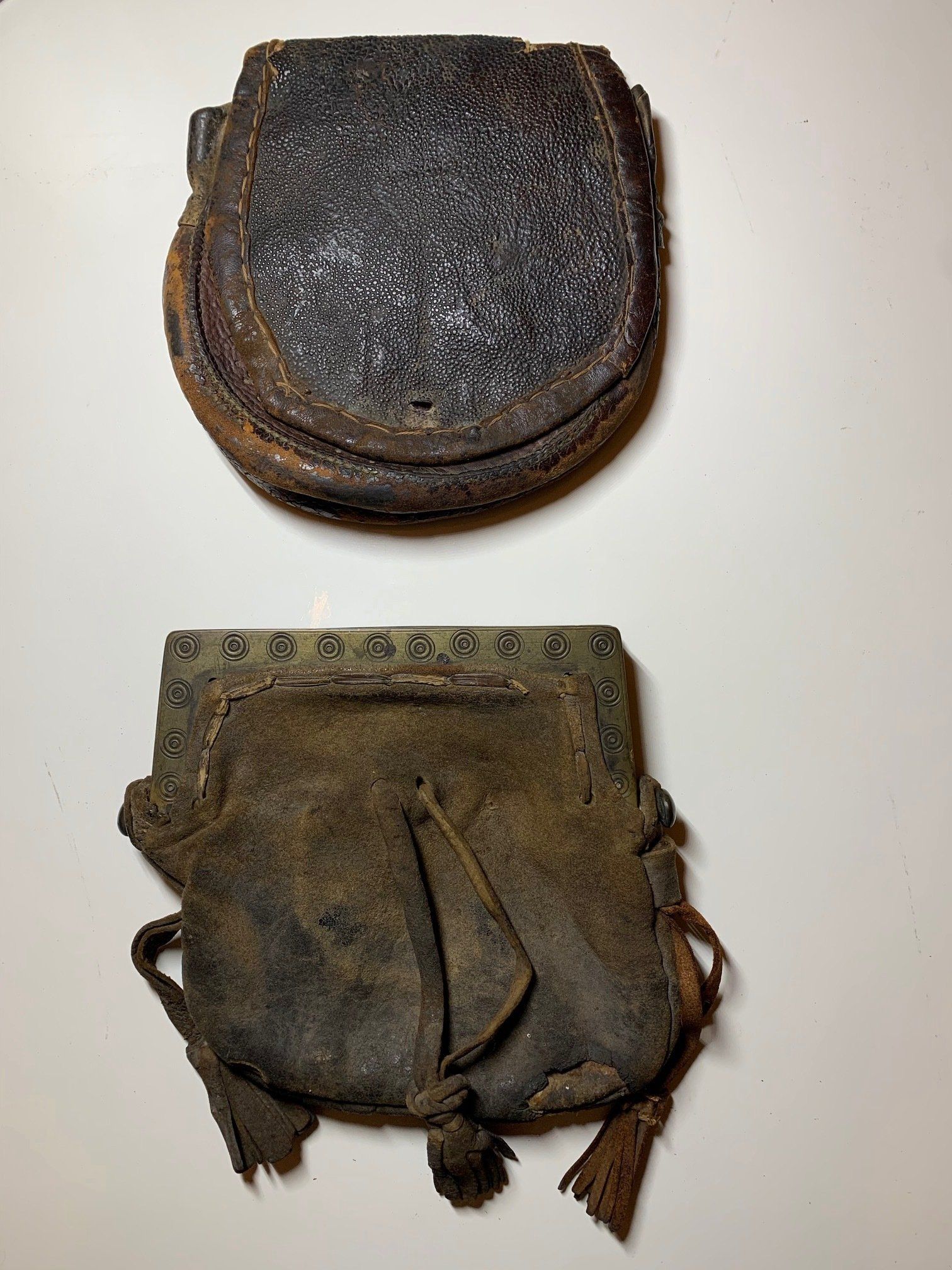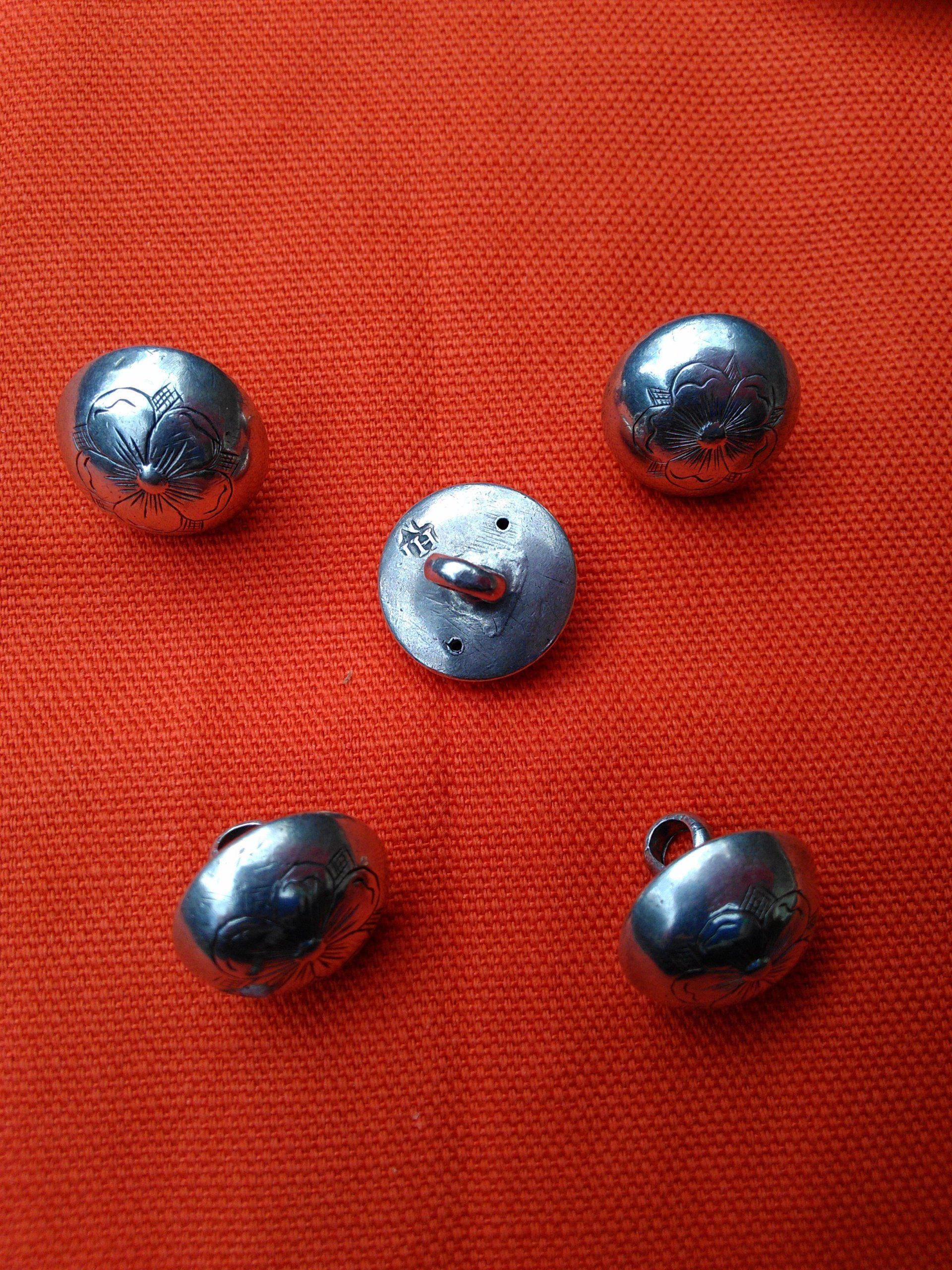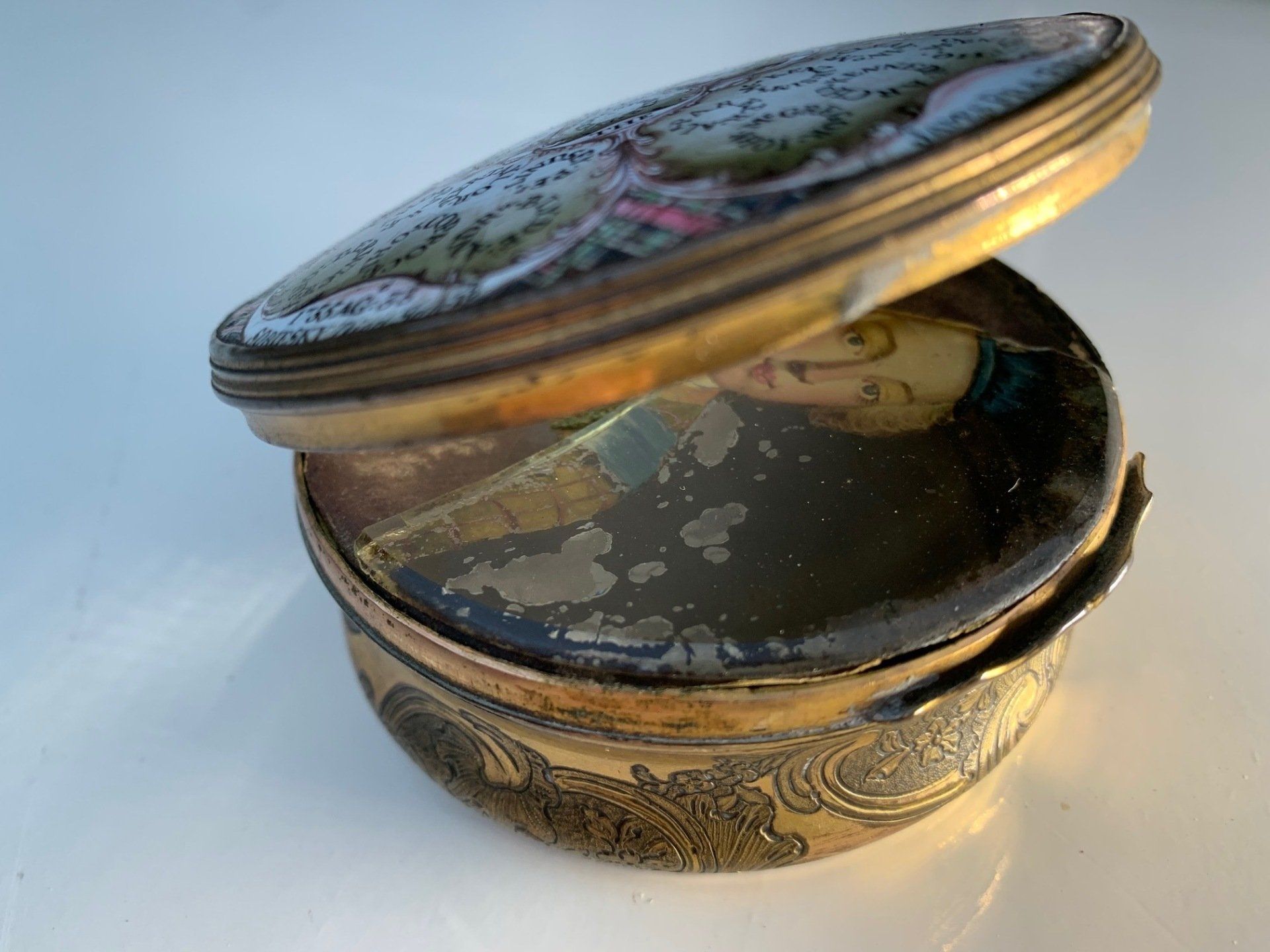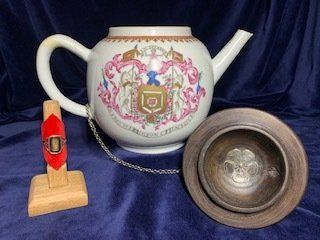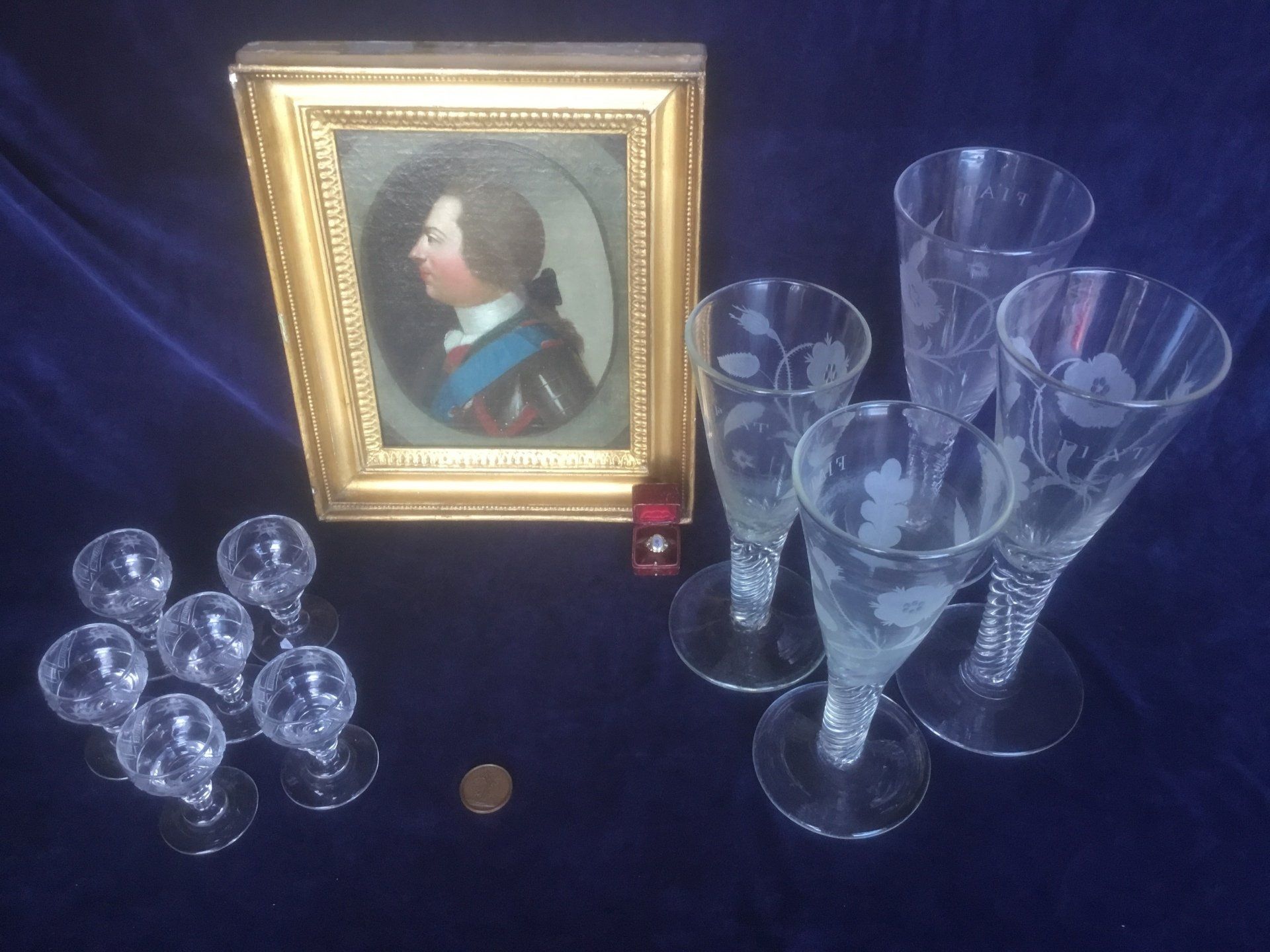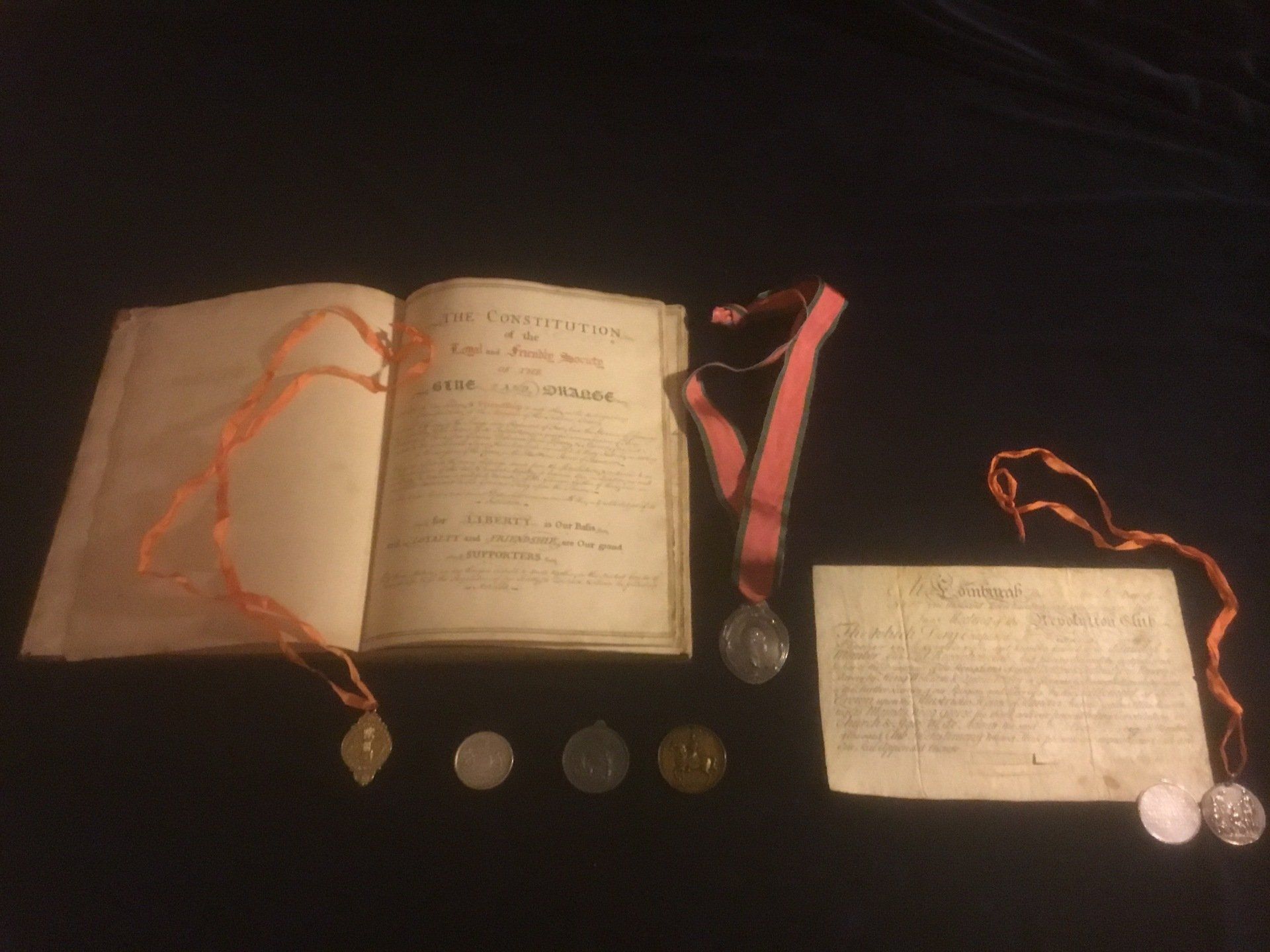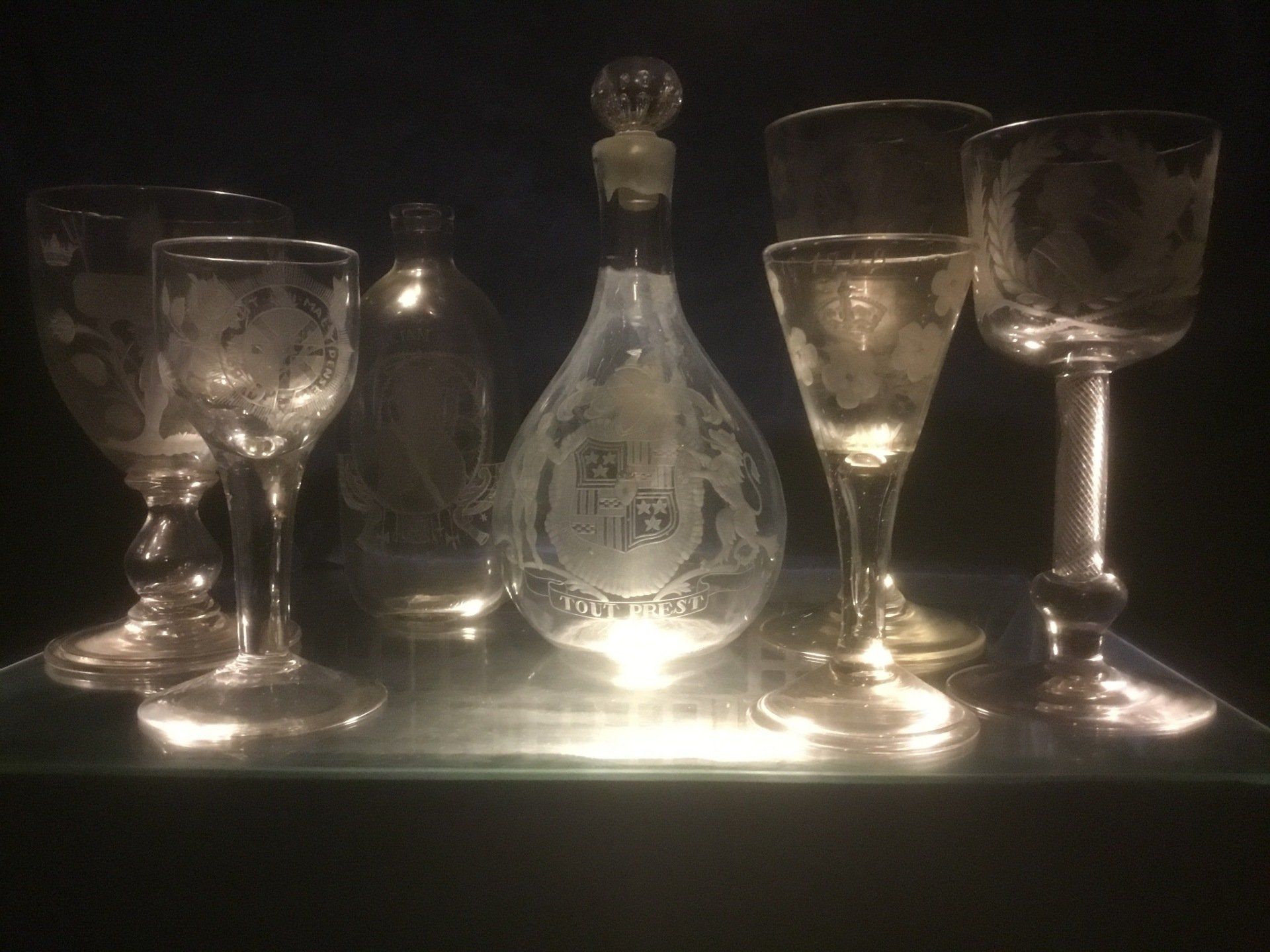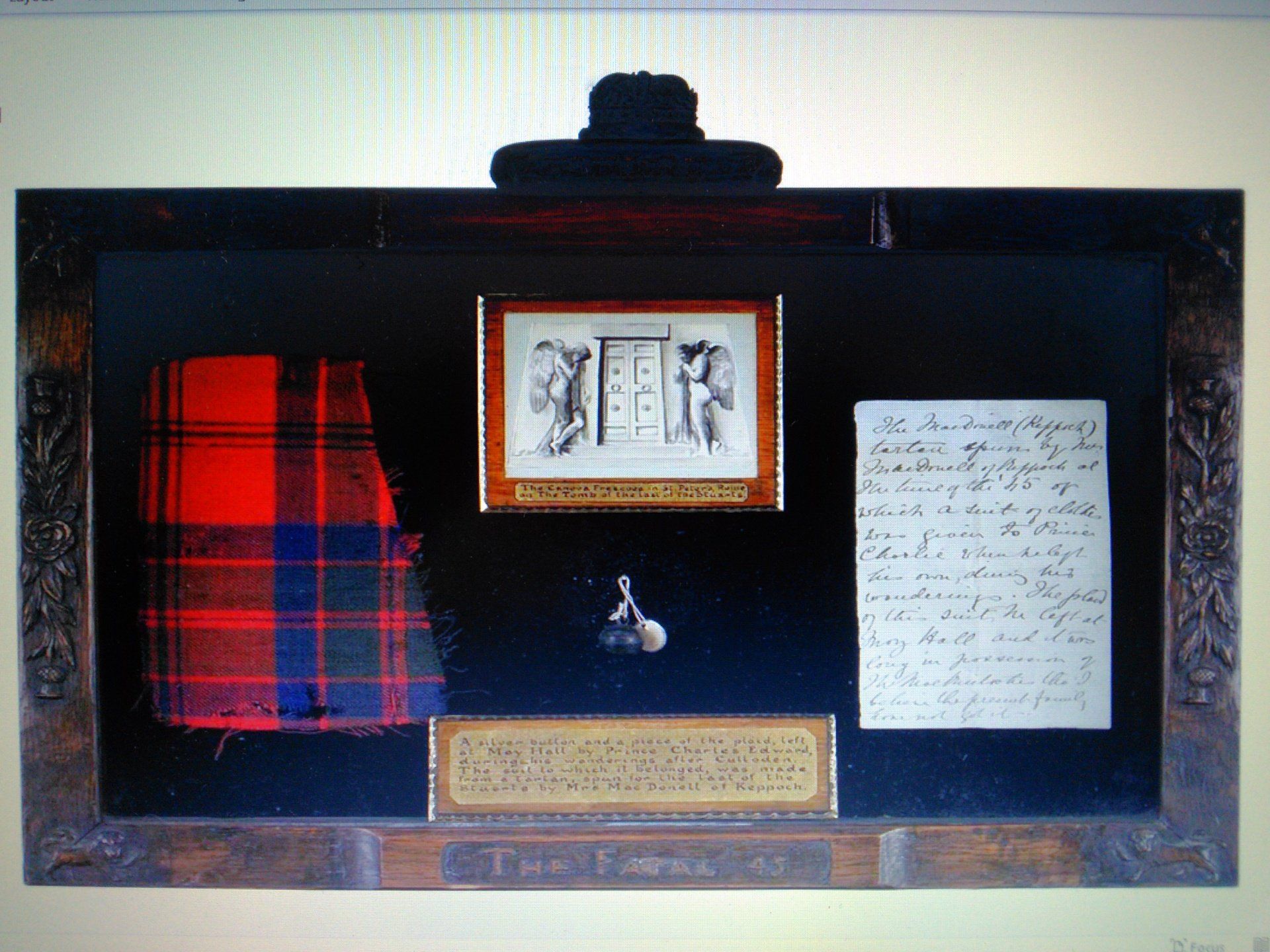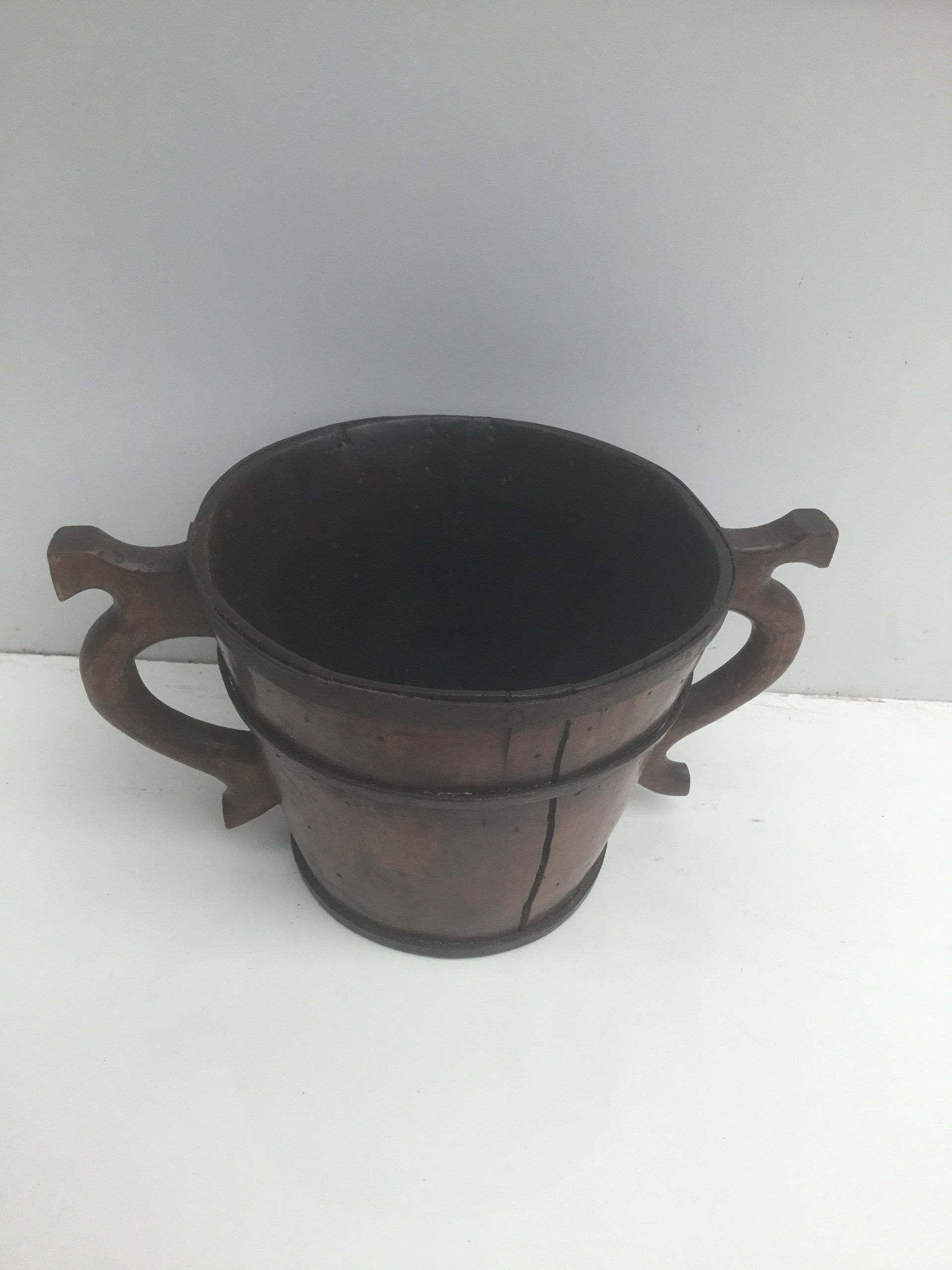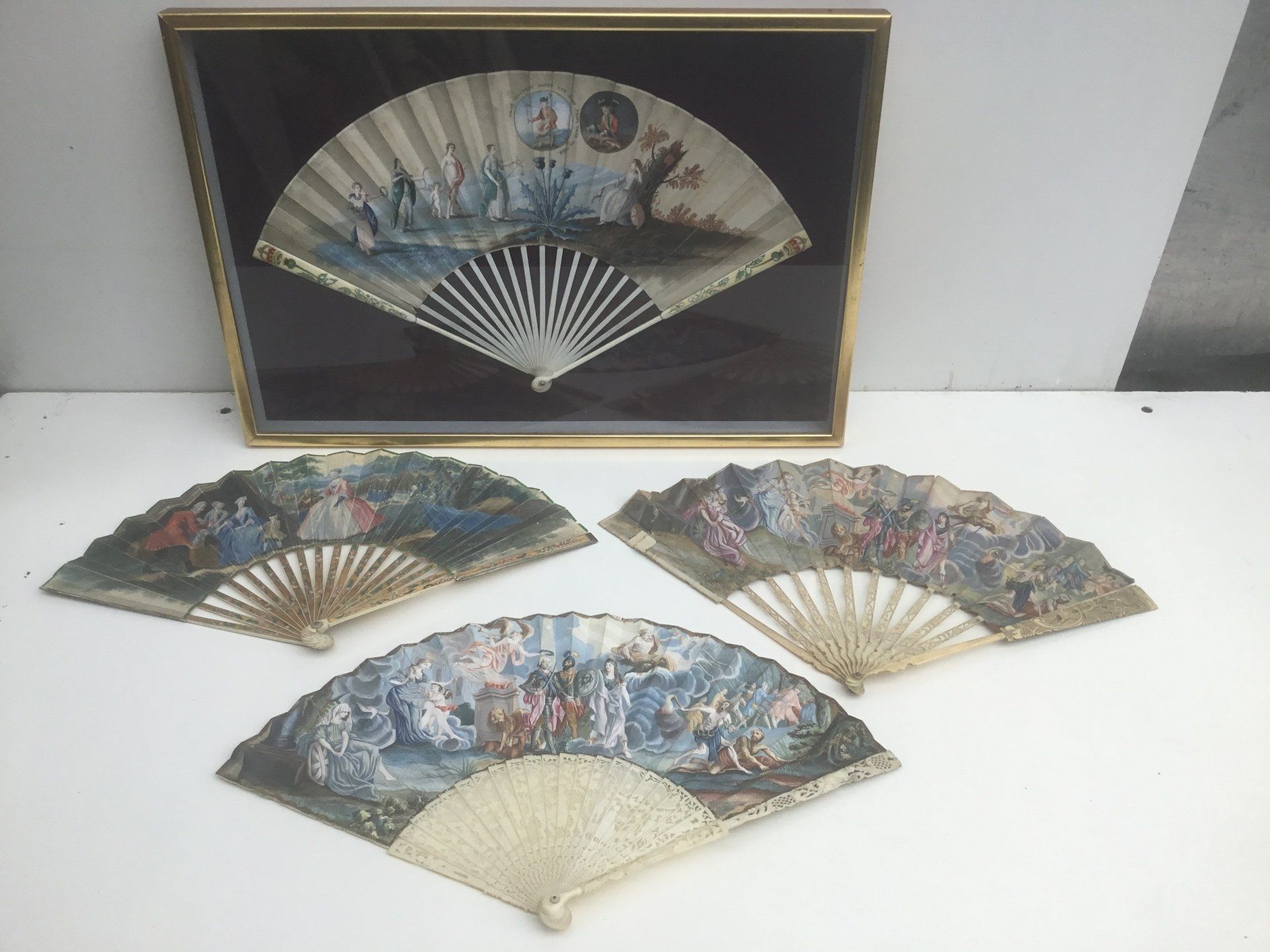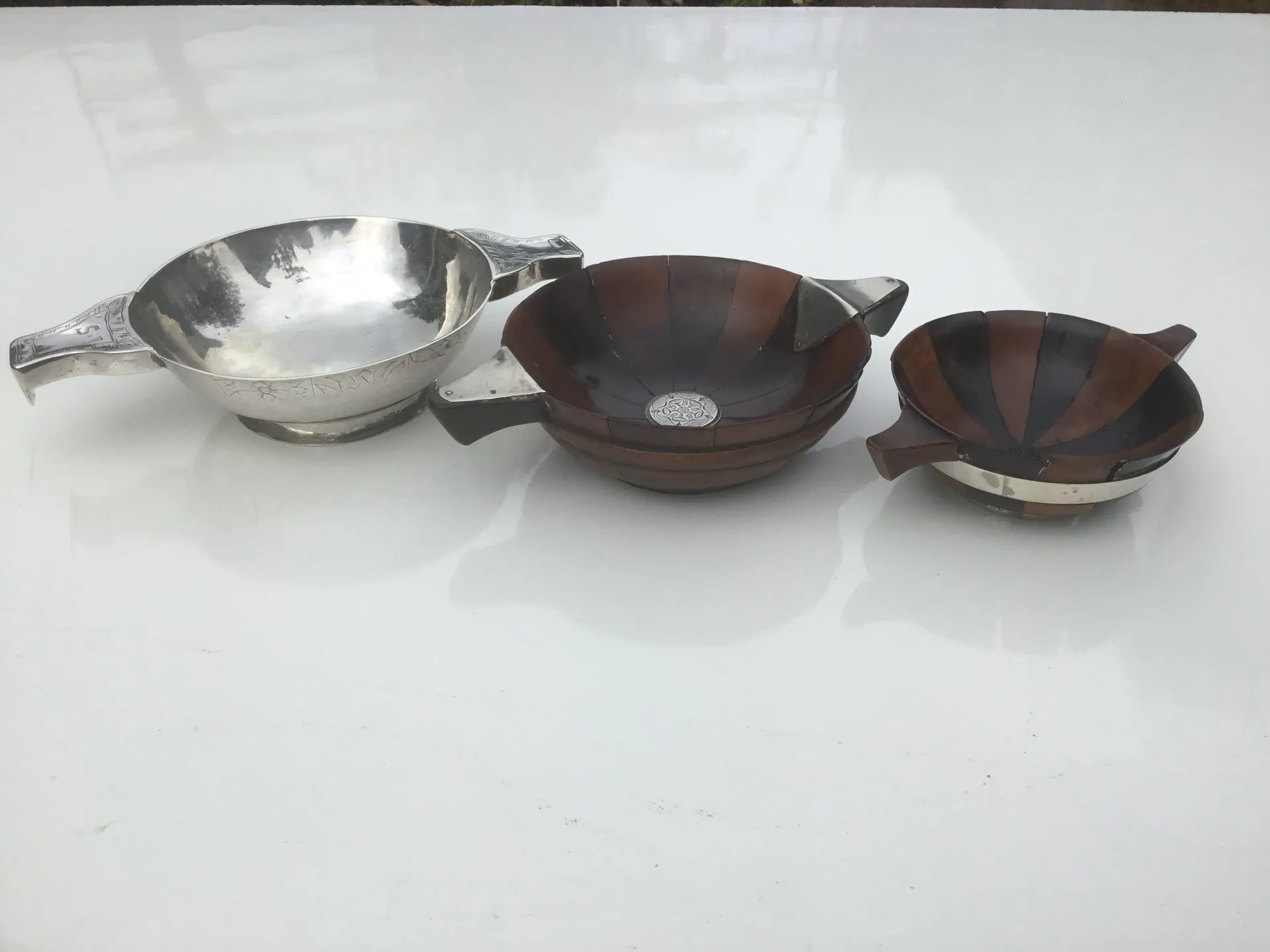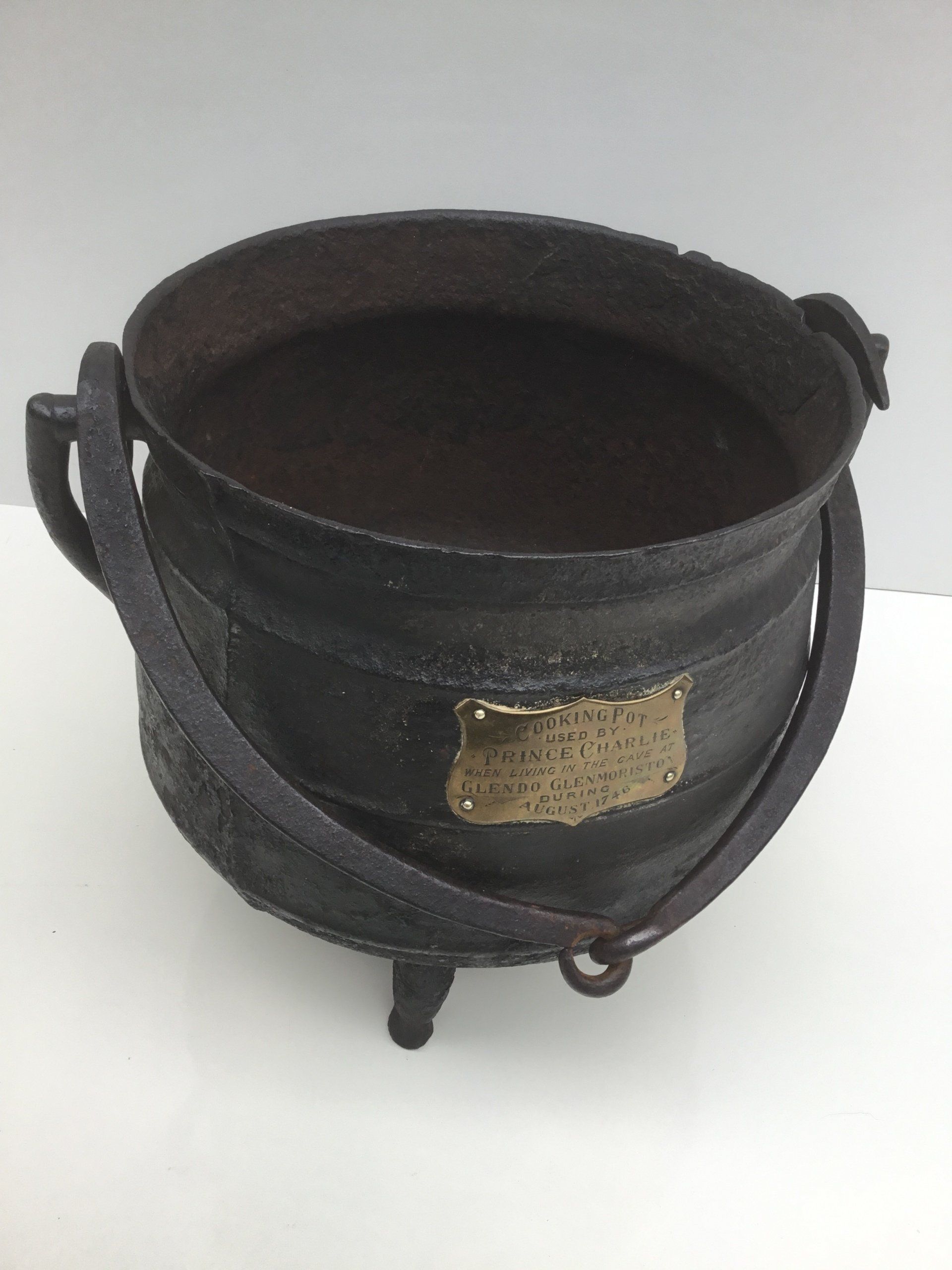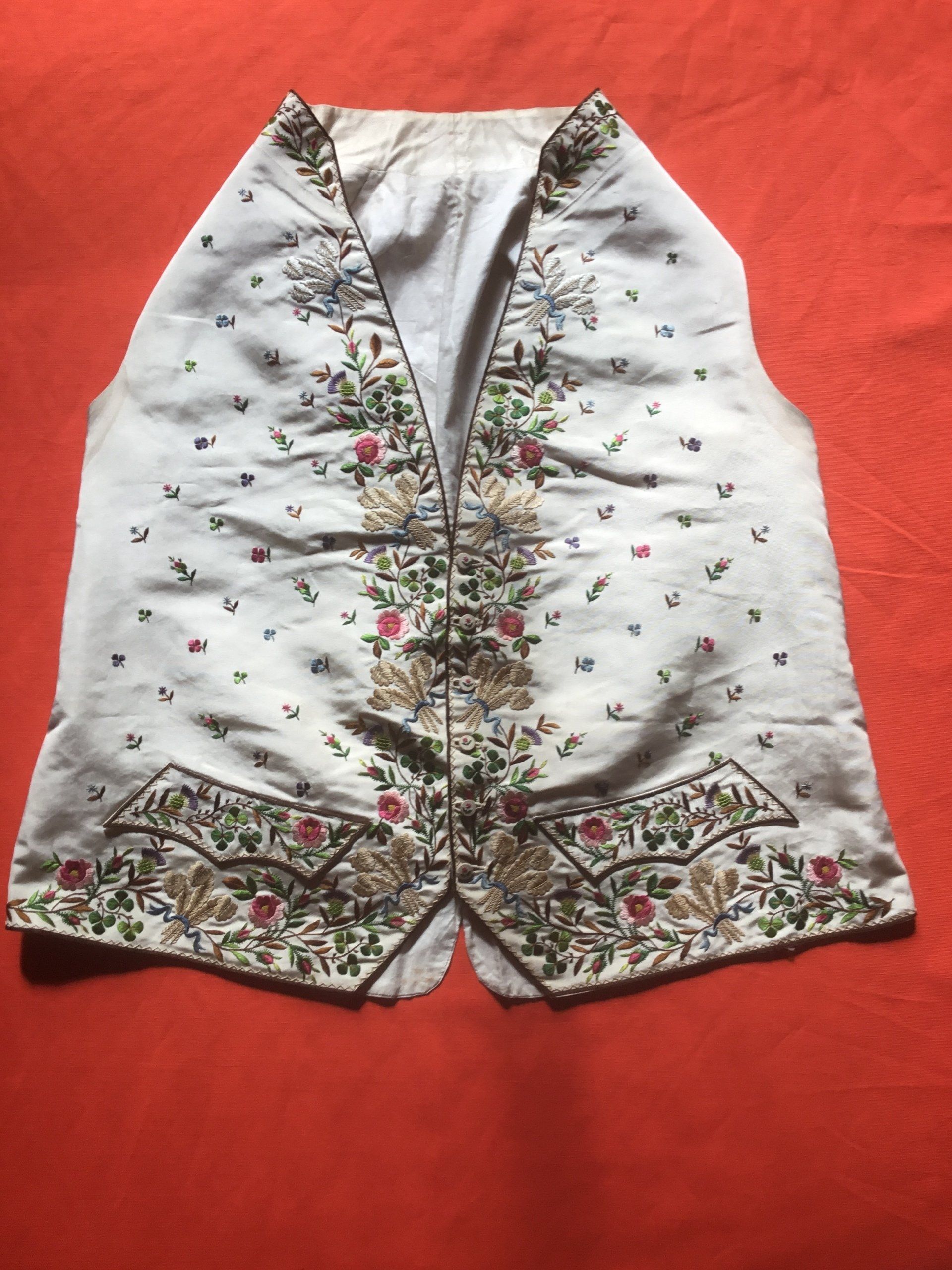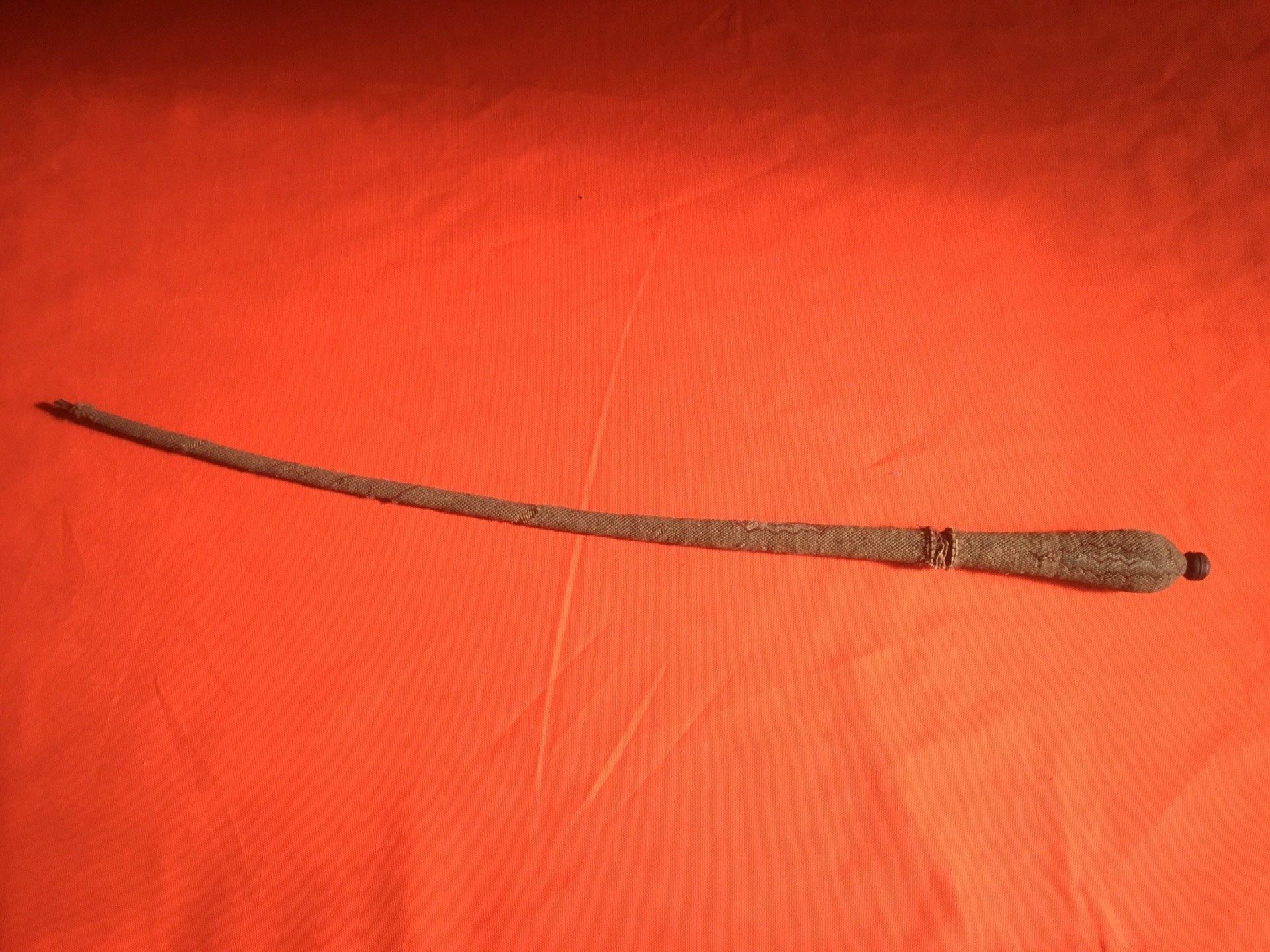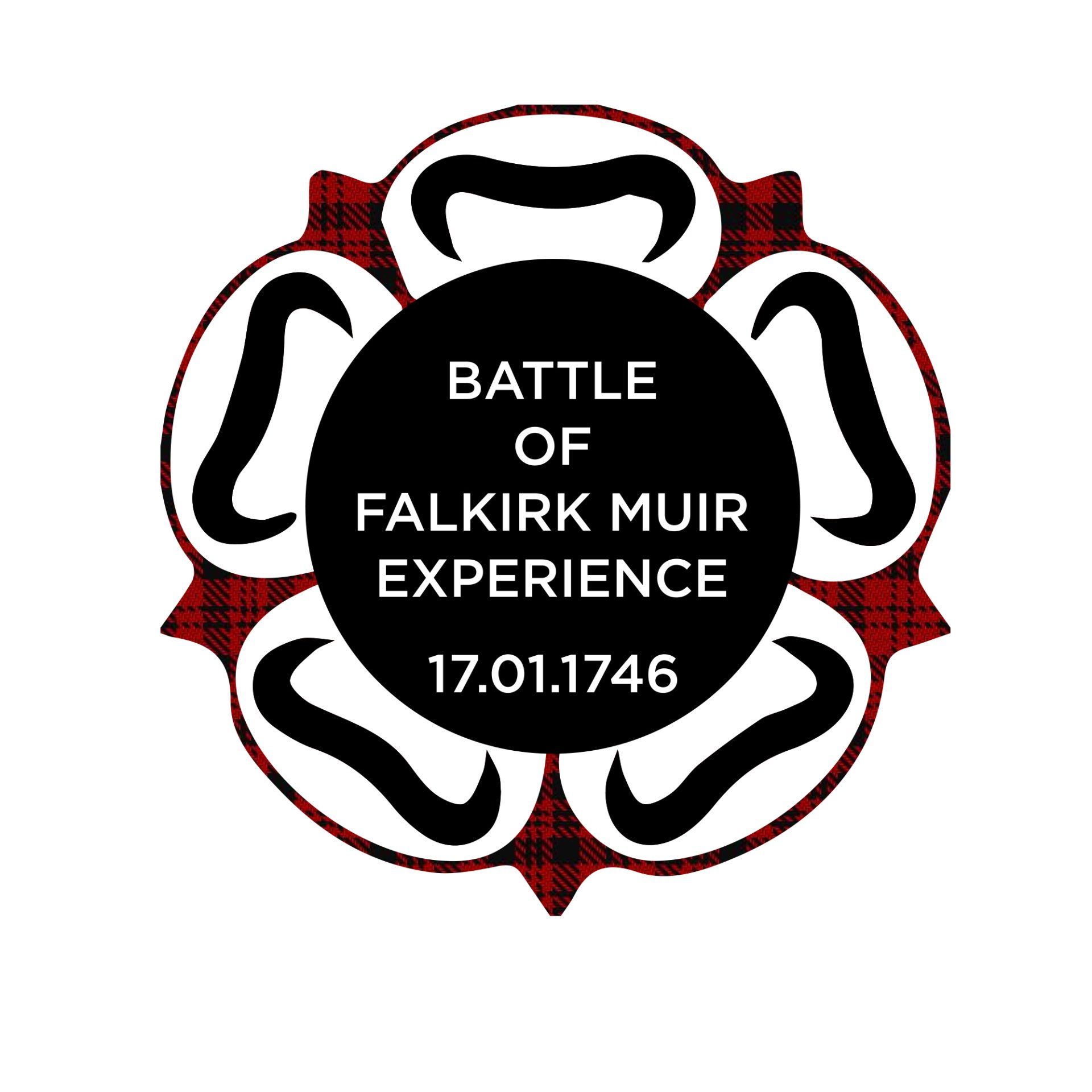Room 3 - Gallery of Personal Items
Lemoyne Ring
This ring is almost identical to a ring once owned by the Setons of Touch. The only difference is that this ring has 1745 enamelled after CPR. We now know the image of Prince Charles is taken from the Lemoyne bust created in 1747. This dates this ring to some time after 1747 but before 1766 when Charles became King and would no longer be known as CPR, Charles Prince Regent. There is a compartment below Charles’ image that contains a hair reputedly from Bonnie Prince Charlie.
Given the superb quality of this ring it is thought to have been crafted by Edinburgh Goldsmith and Jacobite sympathiser Ebaneezer Oliphant. It is one of a small number of Jacobite rings that feature a Thistle and Rose on the shoulder.
Added 15 December 2024
James VIII Ring
This Indian diamond encrusted ring displays a Lemoyne ‘biscuit’. Below there is a
woven piece of hair and the letters CPR in gold. Presumably it is Prince Charles’ hair. The ring is inscribed ‘RIGHT BY MERIT’ perhaps confirming the Stuarts ‘right’ to be King.
It is known that in late 1748 a ring was sent by Prince Charles to his father in Rome. This ring was loaned to the West Highland Museum for their 1925 exhibition. Unfortunately there is not a detailed description of this ring but the details we do have match this ring. Given the amount of Charles’ hair woven on the back he must have been involved in it’s commission and, given the number of diamonds and quality of workmanship it was an expensive item to make.
Added 15 December 2024
Irish Harp Ring
This ring is similar to a ring said to have been owned by Laurence Oliphant. Both these rings have an Irish Harp on the back, a Rose and Thistle on the shoulders and no inscription on the band. Oliphant's ring displays CPR in gold wire under a yellow Citrine while this ring has a purple Saphire.
Given the superb quality of this ring it is thought to have been crafted by Edinburgh Goldsmith and Jacobite sympathiser Ebaneezer Oliphant. It is one of a small number of Jacobite rings that feature a Thistle and Rose on the shoulder.
Added 15 December 2024
Dr Archibald Cameron Ring
This ring is known as a Memento Mori ring. This type of ring was created to commemorate someone who has died. In this case it commemorates Dr Archibald Cameron, brother of 'Gentle Lochiel' the Clan Cameron chief.
The words Dr ARCHIBALD CAMERON OB: 7 June 1753 AEYT 47 (died 7th June 1753 aged 47) are enamelled in white on the band and it displays a yellow Citrine. A hair, presumably belonging to Dr Archie, is shown in the glass below. There is a white rose and thistle on the shoulder of the ring.
Archie served in the Jacobite army throughout the '45 Rising. Indeed he was wounded at the battle of Falkirk Muir.
After fleeing Britain in 1746 Archie returned to retrieve some of the Loch Arkaig gold. He was captured by the British Army while secretly staying at Brenachyle near Loch Katrine after he was betrayed by Alastair MacDonnell of Glengarry, known as ‘Pickle the Spy’. After being held in the Tower of London he was hanged at Tyburn.
He was the last Jacobite to be executed for his part in the ’45.
Added 15 December 2024
Four Peers Rings
The Four Peers ring is one of the most iconic of all Jacobite artifacts. It commemorates the execution of the four Peers, Earl of Kilmarnock, Lord Balmerino, Earl Derwentwater and Lord Lovat for their involvement in the '45 Rising. In addition, the 9 men of the Manchester Regiment and 8 Scotish Jacobites who were also executed by the British Government after the '45 are also commemorated.
The Peers were executed on Tower Hill by the axe. The other 17 men were executed on Kennington Common where they were hanged, drawn while still alive, had their intestines removed and burnt in front of them and then they were quartered.
The Four Peers initials and dates of execution together with an axe are displayed in white enamel on the top. The men’s initials and dates of execution are shown in white enamel in 8 scrolls on the band.
Given the superb quality of this ring it is thought to have been crafted by Edinburgh Goldsmith and Jacobite sympathiser Ebaneezer Oliphant. It is one of a small number of Jacobite rings that feature a Thistle and Rose on the shoulder.
Added 22 November 2024
Silver Tankard
James Ogilvy, 4th Earl of Airlie (Longforgan 1698 - 24 July 1761 Cortachy) Silver Tankard
James Ogilvy came out in the '15 and fought with the Earl of Mar's forces at Sheriffmuir. As a result he was attained and did not receive a pardon until 1725. His son David, the 5th Earl raised a Regiment comprising 600 men which fought at both Falkirk Muir and Culloden.
This large silver tankard with the Earl of Airlie's coat of arms engraved on it was made in Edinburgh in 1720/1721 by Henry Bethune one of the finest silvermakers in Edinburgh at that time. There is good reason to believe that Bethune also had Jacobite sympathies. To demonstrate it's size I have placed a moden £1 coin next to the tankard.
Given the Hallmark date the tankard would have been purchased by the 4th Earl and inheritated by the 5th Earl.
Added 27 August 2024
Kilravock Castle Coconut Cup
This Coconut cup has a silver band below the rim that has the following engraving: 'Charlie's cup at Kilravock Monday April 14th'
It is documented the Prince Charles Edward visited Kilravock Castle, which is situated six miles from Culloden, a couple of days before the battle.
Hugh, the 17th Baron of Kilravock and his Lady entertained the Prince, his secretary, Murray of Broughton, and some of his officers to lunch after which the Baron played a minnet on a Cittern and the men drunk whisky from a punch bowl that was filled with 16 bottles of best whisky.
This cup was used by Bonnie Prince Charlie. As Coconuts were so rare and valuable this type of cup woiuld have been more prestegious than a similar silver cup.
Added 05 July 2024
The Kilravock Castle Cittern
It is documented the Prince Charles Edward visited Kilravock Castle, which is situated six miles from Culloden, a couple of days before the battle.
Hugh, the 17th Baron of Kilravock and his Lady entertained the Prince, his secretary, Murray of Broughton, and some of his officers to lunch after which the Baron played this Cittern.
The castle's history sates that ''Kilravrock who was a capitol performer, having taken up a violin (Cittern) and played an Italian Minnet said to the Prince - ''that if I mistake not is a favourite of your Royal Highness''. ''That is a favourite of mine. Mr Rose is certain but how come you to know that it is so I am quite at a loss to guess''. ''That sir'' replied Mr Rose ''may serve to show you that whatever people of your rank do or say is sure to be remarked'' ''I thank you'' said the Prince for that observation''.
Added 05 July 2024
Kilravock Castle - Punch bowl and plate
It is documented the Prince Charles Edward visited Kilravock Castle, which is situated six miles from Culloden, a couple of days before the battle.
Hugh, the 17th Baron of Kilravock and his Lady entertained the Prince, his secretary, Murray of Broughton, and some of his officers to lunch after which the Baron played a minnet on a Cittern and the men drunk whisky from a punch bowl that was filled with 16 bottles of best whisky.
The castle's history records that after the Royal had dined ''some jocking followed at the expense of the Prince's Secretary who expressed a wish to see a large china bowl capable of containing sixteen bottles of liquor, filled. It was promptly filled with good Whisky punch. After drinking a few glasses of wine the Prince rose to depart but insisted Mr Hay, since he had challenged the bowl, must see it out. He took but one glass and accompanied his master to Culloden''.
Added 05 July 2024
Kilravock Castle - British Army Dragoon boots
The Duke of Cumberland visited the castle on his way from Nairn to the battlefield of Culloden and it is likely that he spent the night after the battle in the castle.
When the Duke's party entered the castle it is recorded that he and Hugh the 17th Baron of Kilravock had the following conversation:
''So I understand you had my cousin Charles here yesterday'' (said the Duke). ''Yes please your Royal Highness'' replied Kilravrock '' not having an armed force I could not prevent him''. ''You did perfectly right'' said the Duke '' and I entirely approve of your conduct''
These heavy square toe knee length boots are constructed out of very thick leather. The top sections of each boots is missing due to wear while being stored in the castle. Boots such as these acted as armour providing protection to the Dragoon's legs from sword cuts while on his horse. One of the boots shows a circular hole that has been repaired by sowing in a patch of leather. It is difficult to determine what caused the hole. It may have been a result of a swipe by a sword, a hit by a musket ball or perhaps just the result of wear and tear. The castle tradition is that these boots were left by one of the Dragoon officers who spent the night in the castle after the battle of Culloden.
Added 05 July 2024
Amen Glass
The Keith-Douglas Amen glass
Amen glasses are the rarest and most iconic of all Jacobite glasses and were the most dangerous of all Jacobite artifacts to own.
One of the original six known Amen glasses. This glass was owned by George Keith Earle Marischal, 10th Earl Marshal while he was living in France after leaving Scotland when the 1715 Rising failed.
The glass is diamond point engraved with JR8 monogram topped with a crown which refers to King James VIII of Scotland. It also has the words of the three verses of the Jacobite Royal Anthem engraved round the body and foot of the glass which ends with Amen, hence the name by which these glasses are known. It also has 'Prince Henry Duke of Albany and York' engraved on the bowl.
Current thinking is that these glasses were engraved by the Jacobite soldier Robert Strange in the late 1740s.
Added 18 Decmeber 2023
Stewart of Appin Glass
During the 18th century the Appin area was a hotbed of Jacobite sympathisers.
Charles Stewart of Arsheal led the clan during the '45 Rising. Charles' father, John, had been out for James VII in 1689. Charles' half brother was James of the Glens. The Museum has this unique early 18th century glass. Its states 'Appin for the cause', 'Damnation to the Union' and 'Hanover to the devil'. The glass is of very high quality so it can be assumed that it could only have been afforded by the Appin clan chief. It must date to around the time of the union of the Parliaments in 1707. It's sentiments are unambiguous and would have been considered treasonable.
Added 23 October 2022
Forbes Notebook
The Lord President's note book
This leather case acted as a cover for Duncan Forbes' note book which I am sure would have made some very interesting reading.
Added 30 May 2022
Forbes Glasses
Now where did I put my Glasses?
These Glasses and Shagreen case belonged to Duncan Forbes whom was Lord President of Scotland during the period of the '45 Rising.
Although Forbes worked hard to keep Clans from turning out for Prince Charles Edward Stuart. His efforts undoubtedly helped to defeat the Charles' attempt to regain his throne.
Added 30 May 2022
James, Duke of York's, dog collar
This leather dog collar was worn by James, Duke of York's dog during hunting.
The collar is emblazoned with two Ducal crowns and with two plaques. One is engraved 'His Royal Highness' the other 'James Duke of York'. The collar would allow his dog to be identified during and after the hunt.
The collar must date to between 1660, the date of The Restoration of the crown and 1685 the year James was crowned James VII of Scotland and James II of England after the death of his brother Charles II.
Added 27 March 2022
Bonnie Prince Charlie Punch Bowl
This is an extremely rare Qianlong-era, mid eighteenth century, punch bowl with a fine portrait of Prince Charles Edward on the outside. It has a white 'Jacobite' rose on the inside which is similar to the iconolgy more commonly used on Jacobite glasses. These images have been enamelled on top of the glaze which is an extremely demanding process. It measures 11'' across.
Added 30 September 2021
Duke of Cumberland Punch Bowl
This punch bowl is an example of a mid eighteenth century Chinese Export Porcelain. It has an image of the Duke of Cumberland on the outside which is surrounded by the inscription 'April 16th 1746 in Remembrance of the Glorious Victory at Culloden'. On the inside there is an image of three swimming goldfish. It measeures 10 1/5'' across.
Added 30 September 2021
Culloden brooch
The image shows the front of a late 17th century brass plaid brooch which measures 4'' across.
This brooch is mentioned in Henrietta & Alistair Tayler's comprehensive history of the Duff family called The Book of the Duffs which tells us that the brooch was collected from the Culloden battlefield.
Added 2 April 2021
Whatever happened to the Jacobite Navy?
During the period October 1745 to March 1746 Montrose harbour was a hub for sailing ships coming and going from France.
A reasonably well known example of this activity was the seizure of a British Navy 14 gun Merlin class Sloop HMS Hazard which ran aground in the harbour. The ship was boarded by a group of Jacobite's who rowed out to the ship, under the cover of night, and took the ship's crew prisoners. The ship was renamed Le Prince Charles.
A letter written by an eye witness to this event can be viewed in Room 4 - Gallery of Printed Works within our Virtual Museum (link below).
Shortly after the capture of HMS Hazard, a French Sloop called La Fine came into the harbour to disembark a Regiment of Ecossais troops including Lord John Drummond, the Duke of Perth, to reinforce Prince Charles' forces that, at that, time were marching towards London.
Just after the troops had been disembarked a British Navy ship called Milford caught up with La Fine and launched an attack that resulted in La Fine becoming grounded and breaking it's back.
The Milford also became grounded but due to the crew's experience they managed to extricate the ship.
The wooden purse shown in the images is made from timbers salvaged from the La Fine. The black label reads 'Part of the French Sloop of war sunk in Montrose harbour in November 1745 when landing troops for Prince Charlie'. The lighter picture on the other side of the purse is a faded image of Montrose harbour.
Given that the ship was used to transfer gold coins from France to Scotland, to help pay for the rising, perhaps it is fitting it has ended up as a purse.
Added 8 March 2021
Lemoyne Snuff Box
This snuff box has been crafted from tortoise shell with silver trims. Hidden away on the inside of the lid there is a silver disc bearing a portrait of Prince Charles Edward Stuart. This is based on the mid 18th century portrait bust by Jean-Baptiste Lemoyne.
Although this snuff box isn't as sophisticated as the boxes that have a secret compartment it performs the same purpose by hiding the owner's true loyalties from unwanted attention. However, when company permitted these loyalties could be displayed.
Added 23 February 2021
Kirkconnell's Secret Snuff Box
This silver snuff box was carried by James Maxwell of Kirkconnell during the '45.
It has a secret compartment that contains a biblical scene. The exact meaning of the scene is uncertain and will require further investigation. However, as the scene was hidden from view, Kirkconnell must have considered the image would be classed as seditious. The snuff was kept in the bottom deeper compartment.
Added 13 February 2021
A Beautiful Spot
This is a beauty spot box.
The top is silver which has a crest incoroprating a trunk of oak eradicated sprouting leaves with the motto: Revirescit [It flourishes again]. These are common Jacobite iconolgy. The crest is of the Belsches of Innermay (or Invermay) in the County of Perthshire.
Below there is a mirror to help with placement of the beauty spot onto the face. Typically the spots were made out of silk or velvet.
Below this lid, there is a compartment Inside which has a rose design. The rose is another Jacobite image.
Added 13 February 2021
Duke of Cumberland Snuff Boxes
The smaller of these two boxes is made of tin and commemorates the Duke of Cumberland's victory at Culloden on 16th April 1746.
The other box is made of paper mache and was made upon his death in 1765 to commemorate his life.
Added 13 February 2021
Charlie's Hair
This silver brooch was owned by Margaret Nairne, 2nd Baroness Nairne, later Countess of Nairne, (1669 - 14 November 1747)
She was a staunch Jacobite and spy who met Queen Anne to get her husband 'off the Tower'. He had been arrested after the Battle of Preston in 1715 on suspicion of being a rebel.
Her daughters were all married off to Jacobites and one of them, Lady Lude, welcomed the Jacobite leader to Blair Castle. Her mother welcomed the Prince to Gask, their family House, after the Battle of Culloden. It was during one of these visits that a lock of the Prince's hair was cut and placed into this brooch.
Added 13 February 2021
Prince Charles' Shoe Buckle
This shoe buckle once belonged to Prince Charles Edward Stuart. He was wearing it on the Western Isles while he was on the run from the British Army after Culloden.
It was presented to Donald Cameron of Glenpean who had acted as his guide through Glen Cosaidh on 21st July 1746 and saved the Prince from falling down a precipice.
The Shoe buckle was later made into a brooch. It was exhibited in The Highland and Jacobite Exhibition of 1903 held in Inverness.
Added 13 February 2021
Pitcairn Medal
This extremely rare medal, there are only four known examples, was produced by Edinburgh Physician Archibald Pitcairn (1652-1713) around 1690. The image is of James VII.
The inscription reads:
Scotland-this is the man you have frequently had promised to you. James, King, of divine origin, who shall again restore to the Scots the Golden Age.
It is not difficult to work out where Archibald Pitcairn's loyalties lay, indeed one of his son's was out in the '15.
Added 27 January 2021
Cardinal York
James VIII's youngest son, Henry Benedict Stuart (Rome 1725-1807 Rome) entered the Catholic church during 1747 and was appointed a Cardinal and ordained a priest in 1748. His official title was Cardinal York.
After his elder brother, Charles Edward Stuart, died in 1788 Henry became the last of the direct Stuart line and was declared Henry IX by his Jacobite supporters.
Many British nobility were keen to meet the Cardinal during their Grand Tour of Italy.
These bronze and silver medallions are still in their original wood and silk lined presentation box. There is an inscription on the inside of the top to say that the recipients were Col FC Philips and Capt G Philips who met with the Cardinal during their visit to Rome during 1802. The Cardinal signed the outside of the top to say the medallions were presented by him personally.
Added 27 January 2021
Lucky Charm?
This silver pendant was worn by James Maxwell of Kirckonnell (Scotland 1708-1762 Scotland) throughout the '45 rising.
Maxwell raised as many of his clan and tenants as he could and joined Prince Charles' forces in Edinburgh. He was subsequently appointed a Captain in Lord Elcho's Lifeguards.
The pendant did prove to be lucky as he survived all the battles.
Added 19 January 2021.
Snuff Mulls
The taking of snuff, which is a form of smokeless tobacco, was a very popular pastime during the eighteenth century.
These two snuff mulls are made out of horn with silver fittings. They date from the late seventeenth or early eifgteenth century. The mull on the left is dated 1704 and has the Prince of Wales feathers engraved on the hinge. This design indicates that it was originally owned by a Jacobite.
The Mull on the right has an indistinct clan crest and motto.
Added 27 January 2021
Secret Portrait Snuff Box
A medallion with conjoined busts has been set on the top of this silver snuff box. From a distance the busts look like those of William III and Mary. However, on closer inspection they are actually the busts of James VIII and his wife Maria Clementina Sobieska.
Inside the box there is a secret compartment that has another medallion set within it. This medallion which is cast and chased by O'Brisset can be easily identified as James VIII and dates the box to just before the '15 rising.
The design of this type of box allowed the owner to use it in public in relative safety without the owner's true loyalties being uncovered. However, once in the company of friends with the same loyalties the overtly Jacobite medallion could be displayed.
Added 27 January 2021
Sporrans
These two leather sporrans date from the late 17th or early 18th century.
Added 19 January 2021.
Where are my keys?
This lock is all that is left of the writing cabinet that Prince Charles used during the '45.
Added 19 January 2021.
Silver Buttons
This set of five silver domed buttons have a rose emblem engraved on them. This may indicate a Jacobite connection.
Work is currently underway to try and date the buttons and determine their place of origin.
Added 13 January 2021.
The Martyr's Box
This extremely scarce gilded enamel box lists the names of all the men who were executed at the end of the '45 Rising except for one. The exception is Dr Archibald Cameron who was captured after returning to Scotland and was executed by the British Government in 1753.
Therefore, this dates the box to between 1747 and 1753.
The box has a secret compartment with a hidden reverse glass portrait of Prince Charles Edward Stuart.
Added 20 December 2020
Duke Of Perth
James Drummond, 6th Earl, 3rd Titular Duke of Perth was one of the two Lieutenant-generals who comanded Prince Charles' forces during the '45 rising. James Drummond died on board the ship taking him to France after his army's defeat at Culloden and was buried at sea
The gold ring is a Memento Mori ring containg the Duke's hair. It is enscribed ' James Drummond, Earl of Perth, 1746'. The hair will have been cut just before or just after his death.
The Teapot from 1744 was gifted to Prince Charles Edward Stuart by the Duke of Perth. It features the Royal Stuart coat of arms flanked by the Royal standard on the left and the Duke of Perth's regimental standard on the right.
Added 1 December 2020
The King’s Touch
The Stuarts, and perhaps more importantly their loyal subjects, believed that they could cure Scrofula also known as the King's Evil by the laying on of hands at a Royal Touching Ceremony. The afflicted would attend the ceremony and would sometimes be given an entrance token. Once in, they would be subject to the laying on of hands by the king and they would then be given a gold or silver touchpiece to wear round their necks.
The one thing that is certain is that the King (or Queen) and the poor Scrofula sufferer handled the touchpiece.
From top to bottom:
Charles II entrance tokens and touchpieces, James II, Queen Anne, James III, Charles III (Bonnie Prince Charlie), Henry IX.
Added 25 October 2020
Jacobite Societies
By their very nature Jacobite Societies were more secretive than the Loyal Associations.
There are a few very well known Societies such as ‘The Sea Sergeants’, ‘The Friendly Hunt’ and Cycle clubs, other met in private.
From left to right: six 'Garter Star' glasses used by one of the Welsh Cycle Clubs, ‘Success to the Society‘, ‘The Friendly Hunt’, portrait of Prince Charles and chairman’s ring from The Sea Sergeants, 1750 Oak Society medallion and four communal drinking glasses for passing round the membership from an unknown society.
The Sea Sergeants actively encouraged female participation in the society.
Added 25 October 2020
Loyal Associations
During the 18th century numerous Loyal Associations were formed whereby these Associations demonstrated their allegiance to the Hanoverian regime.
From left to right:
Ther Loyal and Friendly Society of the Blue and Orange, constitution book and gold medallion, Friendly Society medal, Volunteer Regiments medal, Loyal Orange medal, a trial strike of the Cumberland Society medal, The Edinburgh Revolution Club member's Diploma and silver medals. This society met in a room in Blair Street off the High Street. They printed a song book so that members would know the words of the songs sung during their meetings.
Added 19 October 2020
18th Century Glass
Etched glass was a popular way for the supporters of both sides to show their allegiance. The selection here from left to right are as follows:
The Devil takes the House of Hanover, Garter star, Duke of Cumberland flask, Marquess of Tullibardine wine decanter, wine glass dated 1748, two Prince Charles portrait glasses.
Added 20 October 2020
MacDonnell of Keppoch Tartan
Less than forty peices of tartan plaid survive from 1745.
This piece has been analysed by Peter Eslea MacDonald a tartan historian who is associated with The Scottish Tartan Authority.
His investigation indicates that the plaid dates from the '45 rising. It is of the MacDonnell of Keppoch tartan and is likely that it has come from the sleeve of a jacket. The jacket would have been a prestigious peice of clothing which would have been worn by the higher echelons of the clan perhaps by the clan chief himself who fought and was killed at Culloden.
Click on the image to read the full report.
Added 20 September 2020
Rob Roy's Cup
This 17th century cup has been carved out of a single piece of wood reinforced with three iron rings and it belonged to Rob Roy MacGregor.
Added 16 August 2020
Fans of War
These four 18th century fans are made from ivory and paper.
The fan on the middle left represents The Duke of Cumberland's army
The other three fans were owned by Jacobite supporters. The two in the front were given out to the ladies who attended a ball given by Bonnie prince Charlie at the Palace of Holyroodhouse in Edinburgh on 23rd Spetember 1745. The image is thought to have been designed by Robert Strange. The framed fan depicts Britania sitting next to a withered oak tree which shows new growth. The oak tree represents the Royal House of Stuart who's fortunes were improving due to the exploits of Bonnie Prince Charlie.
Added 16 August 2020
Three Jacobite Quaichs
These three 17th century quaichs all have a Jacobite connection. From left to right:
This silver quaich was owned by the Earl of Kilmarnock. His wife Anne took it down to London for her husband to take a last drink of wine before he mounted the scaffolding for his execution in 1746.
The middle quaich is made of fruit wood. It was used by Prince Charles Edward Stuart while visiting a supporter on his way to Edinburgh during 1745. The quaich has a silver medallion in the centre with the Prince's cypher,
The quaich on the right is also made of fruitwood. It has a silver band round the base that states that the quaich was used by John Graham, Viscount Dundee, the commander of the Jacobite army at the Battle of Killiecrankie in 1689.
Narrative updated 1 January 2021
Prince Charles Edward Stuart's Cooking Pot
This 17th century iron cooking pot was used by Bonnie Prince Charlie and the seven men of Glenmoriston in their famous hideout, the cave of Rory the Hunter, in 1746 while they were on the run from the Redcoats after the Battle of Culloden. The pot remained in the family of one of the men, Alexander MacDonald.
In 1996, the pot was lent to Culloden for their major exhibition 'The swords and the sorrows'.
Added 28 June 2020
Prince Charles Edward Stuart's Waistcoat
This heavily embroidered cream silk waistcoat was worn by Bonnie Prince Charlie during the '45 rising. After the Battle of Falkirk on the 17th January 1746 the Jacobite army made a move to head north towards Inverness. Charles visited many of his supporters on the way north and this garment was left by him in a Perthshire castle after he spent the night there.
The predominant symbols are that of the Prince of Wales feathers and fully opened flowering roses together with rose buds. Charles Edward Stuart was the De Facto Prince of Wales. The open rose is known to represent James Francis Stuart while the buds represent Charles and his younger brother Henry.
Added 14 June 2020
Prince Charles Edward Stuart's Riding Whip
This riding whip was carried by Bonnie Prince Charlie during the '45 rising. Although Charles was on foot during the Battle of Prestonpans, it is very likely that he was holding the whip during the Battle of Falkirk and Culloden as he remained mounted during the course of these two battles.
Although most of the colour has faded, the designs on the whip would have been bold and very bright. The cloth covers a length of wood.
Added 14 June 2020

